The crowning glory of the Historic Center of Mexico City is the enormous Cathedral of the Assumption of the Most Blessed Virgin Mary into Heavens. The stone monument dominates the border of the huge Plaza del Zócalo. While its full name is “Cathedral of the Assumption of the Most Blessed Virgin Mary into Heavens” it also goes by the much shorter nickname “Metropolitan Cathedral” or “Mexico City Cathedral.” The enormous church has stood here for over 400 years, but this site was once of great importance to the Aztec people long before that. Walking on the stones here gives you a deep sense that you are stepping into an area of great cultural significance. With a history spanning thousands of years.
The towering ornate church is considered one of the masterpieces of Mexican architecture and is Latin America’s largest and oldest cathedral. If you’re visiting Mexico City you absolutely need to make a stop inside! Explore the interiors and wonder at the amazing monuments, chapels, architecture and incredible atmosphere found inside the Mexico City Cathedral. This guide is the best way to tour it for yourself at your own pace. It will lead you from the exterior courtyard, inner nave, altars and chapels and finally finished at the adjacent Sagrario Metropolitano.
- Access, Hours and Admission
- Aztec History
- Construction of the Catholic Cathedral
- Facade
- Bell Tower
- Interior
- Altar of Forgiveness
- Chapel of the Immaculate Conception
- Chapel of Our Lady of Guadalupe
- Vestibule Paintings
- Choir
- Pendulum
- Major Altar
- Chapel of Saint Peter
- Chapel of the Reliquaries
- Sacristy
- Altar of the Kings
- Philip of Jesus Chapel
- Sagrario Metropolitano
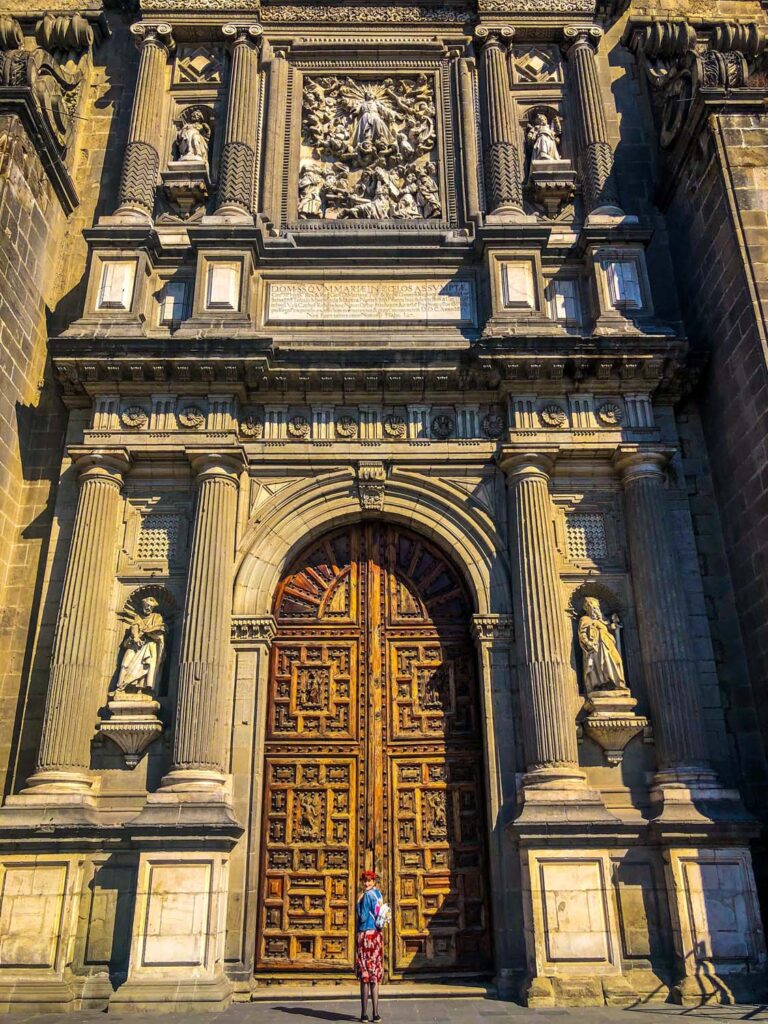
Access, Hours and Admission
The Mexico City Metropolitan Cathedral is located on the north side of Mexico City’s Zócalo. If you are arriving by metro, take the blue line to the Zócalo metro station. When exiting follow the signs for the Cathedral. If you’re taking an Uber, be aware some area of the Historic District are traffic restricted. So your drop-off location might not be right at the front gates of the church. But no worries, the Cathedral is so huge that no matter where you’re dropped off, you’ll be able to spot the towers from a mile away. I actually think the lead up to the grand reveal of the Cathedral is better this way!
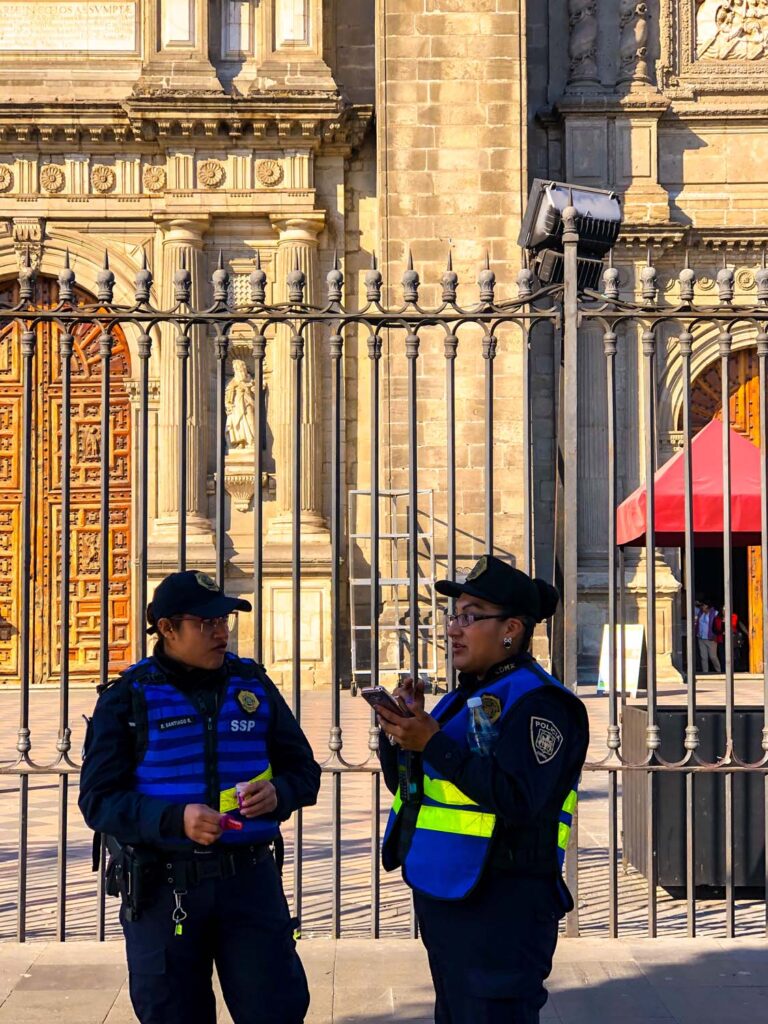
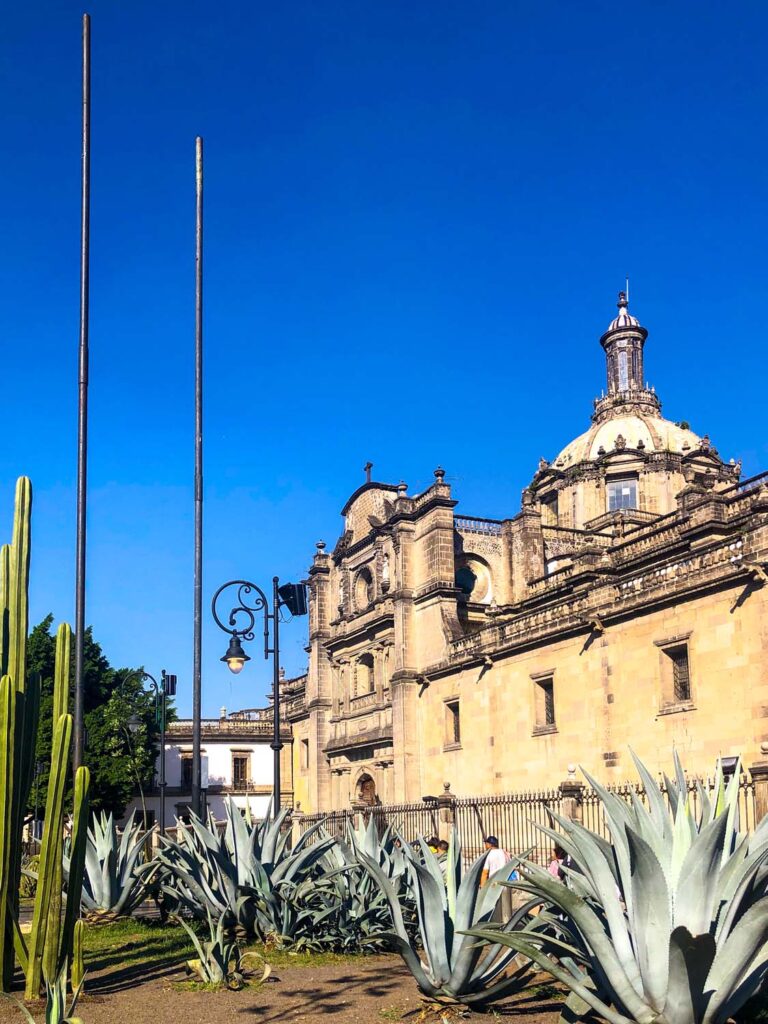
The Cathedral is open from 8am to 8pm every day, including holidays. During certain religious services, parts of the Cathedral will be closed. You’ll still be able to come inside and even listen to the service. Anytime the choir is singing is an extraordinary moment to experience. There is no admission to enter the great Cathedral, but donations are suggested to enter either the Choir or Sacristy.
Ettiquette
Remember not to use any flash photography and speak at a respectable volume since it is still a functional Cathedral. No caps or hats are allowed to be worn on the hat inside out of respect. Shoulders should generally be covered but I didn’t see anyone strictly enforcing.
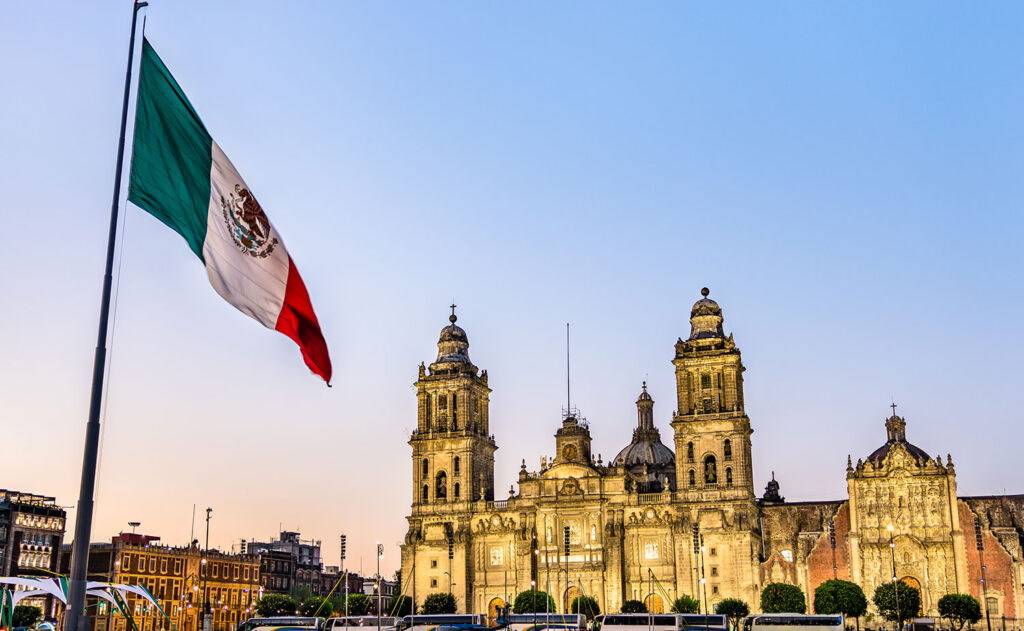
Notes on “Guides” at the Front Gates
So-called “guides” hover around suspected tourists who enter the church grounds. They will approach you for a paid guided tour of the interior. These “guides” will not be able to enter the Cathedral without you in tow. So the interior will be a safe space for these touts. Generally, they will wear badges, claiming that they are government-licensed. But it’s tough to tell these apart from the scammers. In general, it’s a pretty light “scam” as they will indeed lead you around the church. But depending on what guide you might get, they might not really know their stuff. Generally, they are very easygoing if you politely refuse. But if you want to avoid any back and forth, just say, “Oh no, we’ve been here before, just going inside to pray, thanks.” They will figure you aren’t an easy mark and move on.
Aztec History
Long before the church was even a twinkle in the eyes of Hernán Cortés, the site was the locations of the Templo Mayor of the Aztec City of Tenochtitlan once stood. The Aztec temple was built in honour of the god Huītzilōpōchtli and the god Quetzalcoatl, representing the sun and the rain. The Great Temple was a thing of absolute splendour. But Cortés saw it as “savage” and something to be destroyed, along with the beautiful Aztec culture. Cortés had the temple destroyed but saved the Templo mayor’s stones to build his new Catholic Cathedral. Many people claim that it was Cortés himself who laid the first stone.
Construction of the Catholic Cathedral
The construction of Mexico City’s Cathedral began in 1573 and took until 1813 to complete! That’s over 240 years! The enormous Cathedral is over 350 feet long and 200 feet wide. The size perhaps one of the reasons why construction took so long. But the grandiose size makes it Latin America’s largest and oldest Cathedral.
Construction Problems
When the first church was built on this site, it was deemed almost laughable by visitors. It was designed by architect Martín de Sepúlveda between 1524 and 1532. They called it the “Cathedral of Zumárraga,” and parts of the church still remain inside what is now the northeastern part of the building. This church was supposed to be an example of Spain’s greatness. But visitors people found the diminutive size a real disappointment. So in the 16th century, they developed a new design for the expansion of the church. This one would be so sumptuous and impressive it would surely wow any guest from anywhere in the world.
But such great Cathedrals were tough to build, especially on such swampy soil. Before the arrival of the Spanish conquistadors, the Aztecs had created an enormous series of canals and waterways into the city. This brought fresh water from the mountains into the otherwise-dry valley metropolis. The Spanish thought these canals took up valuable real estate inside their new city and had them filled in! This halted the ability to get fresh water into the city (an issue Mexico City continues to struggle with today.) But for the Cathedral’s construction, this meant that the grounds in Mexico City were very soft and swampy. The stones required for these great cathedrals weren’t light. Architects told the Spanish that whatever structure they created would sink into the ground, but the development wouldn’t be stopped.
Style of the Cathedral
Tezontle and the Chiluca Stones were the chosen building material. They could be quarried in a nearby mine and were some of the lightest stones they could source for construction. Claudio de Arciniega was a Spanish architect and sculptor who was brought on to design the new vision of the grand Mexico City Cathedral. Claudio de Arciniega had already built the viceroy’s palace from the remains of Montezuma’s home and created Mexico City’s university. He would go on to work on the Mexico City Cathedral until he died in 1593.
Claudio de Arciniega is primarily responsible for the incredible Herrerian style of the exterior facade. The Cathedral is a patchwork quilt of different kinds of architecture due to the extended period of its construction. The various architectural characteristics you’ll find range from the aforementioned Herrerian style on the exterior, the ultra-Baroque interior chapels, and the imposing Neoclassical dome.
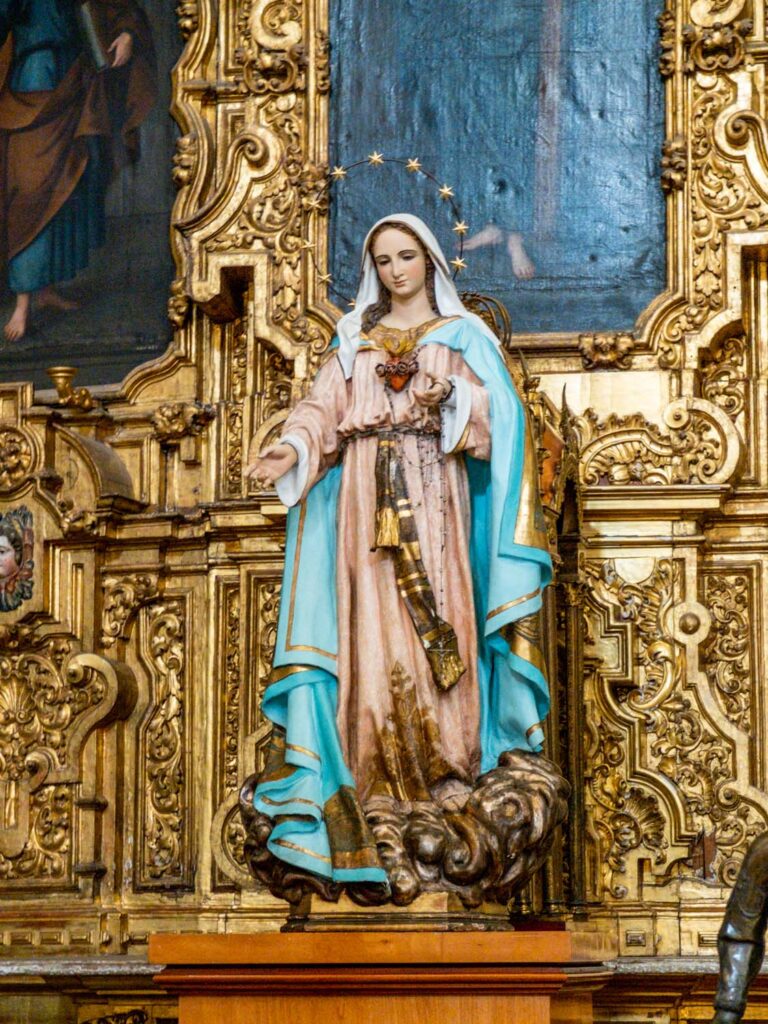
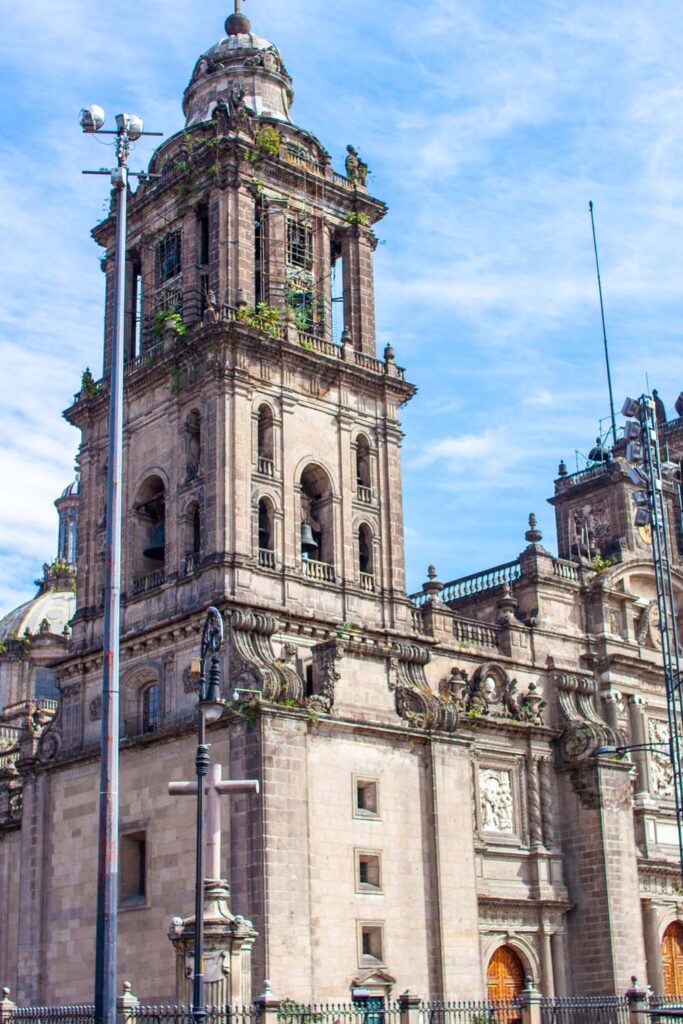
Skull & Cross Column
On a huge stone column, guarding the entrance to the Cathedral grounds is a large, red stone cross. This cross was originally installed in the Cathedral’s cemetery, once located outside the main gates. When the cemetery was moved off the premises, the cross was relocated to this position inside the Cathedral’s courtyard. The base of the stone cross is wrapped in a crown of thorns and the base of the column is surrounded by carvings of human skulls. This is a fairly odd image to see but it pays homage to the Aztec heritage that was discovered on this site.
In 2017, archeologists working in the area discovered a 15th-century tower of human skulls just below the foundations of the Cathedral. These contained 119 skulls from men, women and even children. Archeologists think this tower of sacrifical skulls was created by the Tenochtitlan people to scare the Spanish conquistadores when they arrived to capture their city.

Facade
Walking up to the Cathedral, you’ll have to crane your neck to take in the splendour that stretches up above you, towering over your head. In the light of the morning and at dusk the pale stone is cast in a beautiful golden glow.
Despite the Cathedral’s actual middling height, it feels much taller. This is due to the ingenious design. The facade was made in the 17th century with some reconstruction work done in the early 19th century. The style applied to the facade is called “Herrerian,” after architect Juan de Herrera who was the originator of the design. He was an iconic Spanish architect whose characteristic use of geometry, mathematical equations, clean volumes, and areas of ornamental absence became a popular trend.
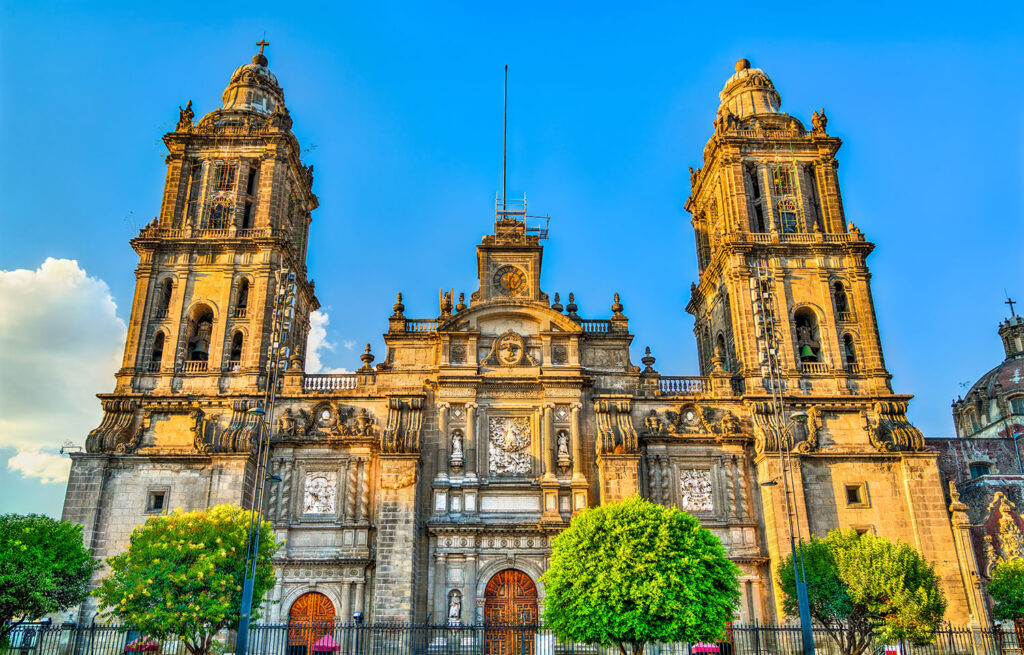
Using specific formulas, balancing different shapes, and carefully arranging construction elements, Herrerian buildings achieved a severe horizontality. Despite not being as ornamental as other design styles from this period such as Spanish Renaissance, Herrerian buildings nevertheless feel grandiose as the elevation truly makes them feel imposing.
Standing for a time in front of the church to appreciate how the more ornamentals parts of the building are broken up with plainer columns of sheer vertical stone. This not only frames the areas of high design but also draws your eye upwards.

Main Facade
Three huge portals flank the southside, the largest facade that serves as the primary entrance to the church. The doors in the center stretch up even higher than the entrances on either side. On either side of the doors, on the street level, are statues of Saint Peter and Paul the Apostle. Above them is a large bas relief carving of the Assumption of the Virgin Mary, for whom the Mexico City Cathedral is dedicated. Guarding the mother on either side are statues of Saint Matthew and Saint Andrew. I love the different carved designs on the stones around the portals and niches. They are all geometric and linear and create the most interesting graphical patterns surrounding the figures.
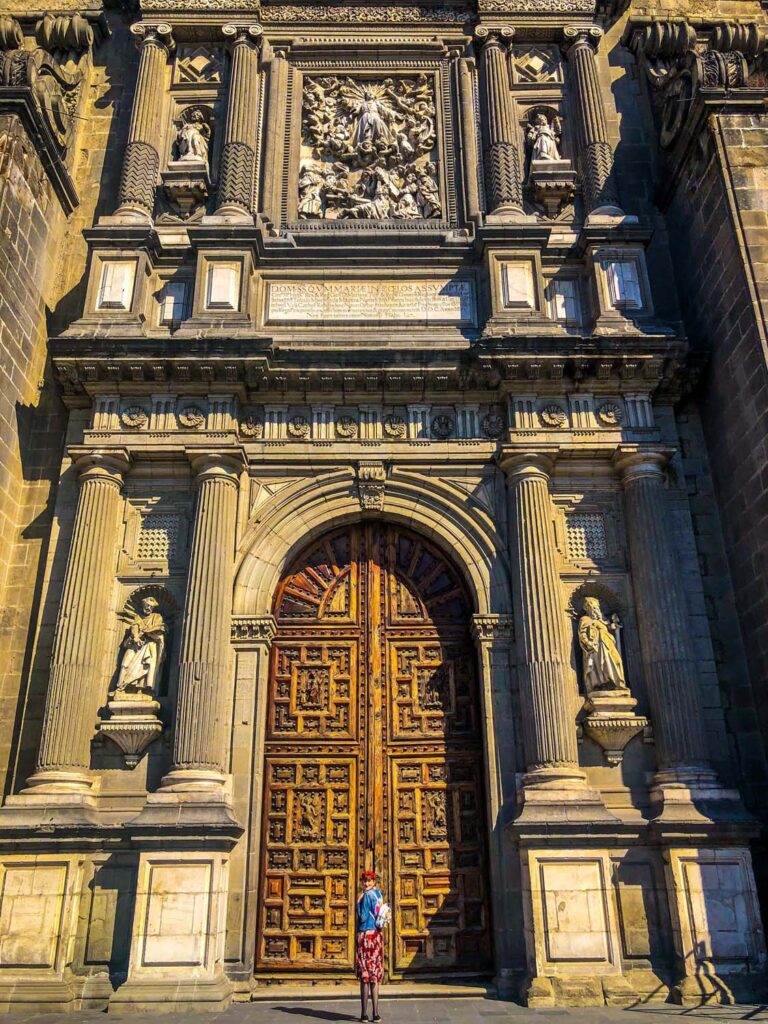
Mexican Coat of Arms
In a sandstone medallion on the floor above is the giant image of the Mexican coat of arms. We can see the huge eagle with its wings spread flying high above us. In its talons, it clutches a snake as it sits perched on the nopales cactus leaf. This symbol is the vision that the Aztec people of Teotihuacan were sent by their gods. Wherever they saw the eagle with the snake was where their gods told them to build their Templo Mayor. Despite the temple being destroyed, it’s nice to see the emblem still crowns the Cathedral’s entrance. Adding one last layer to this enormous church is the clock tower portal. The clock is topped with the Mexican flag and flanked on either corner by large sculptures.

East & West Facade
To the right of the main entrance is the East Facade. On the bas relief above the doorway, you can make out the image of a large ship carrying the four apostles. At the helm of the ship is Saint Peter. Saint Peter is taking them on the seas towards Eternity. On the left side of the main entrance is the West Facade. This bas relief portrays Jesus handing the keys to Heaven over to Saint Peter. Both of these reliefs are framed in between one of my favourite architectural elements, the Solomonic column. The Solomonic column, also called the Barley-sugar column, is characterized by that spiralling shaft, almost like a corkscrew. Or like soft-serve ice cream! Each one of these reliefs was inspired by the painter Peter Paul Rubens’ languid and fluid style.

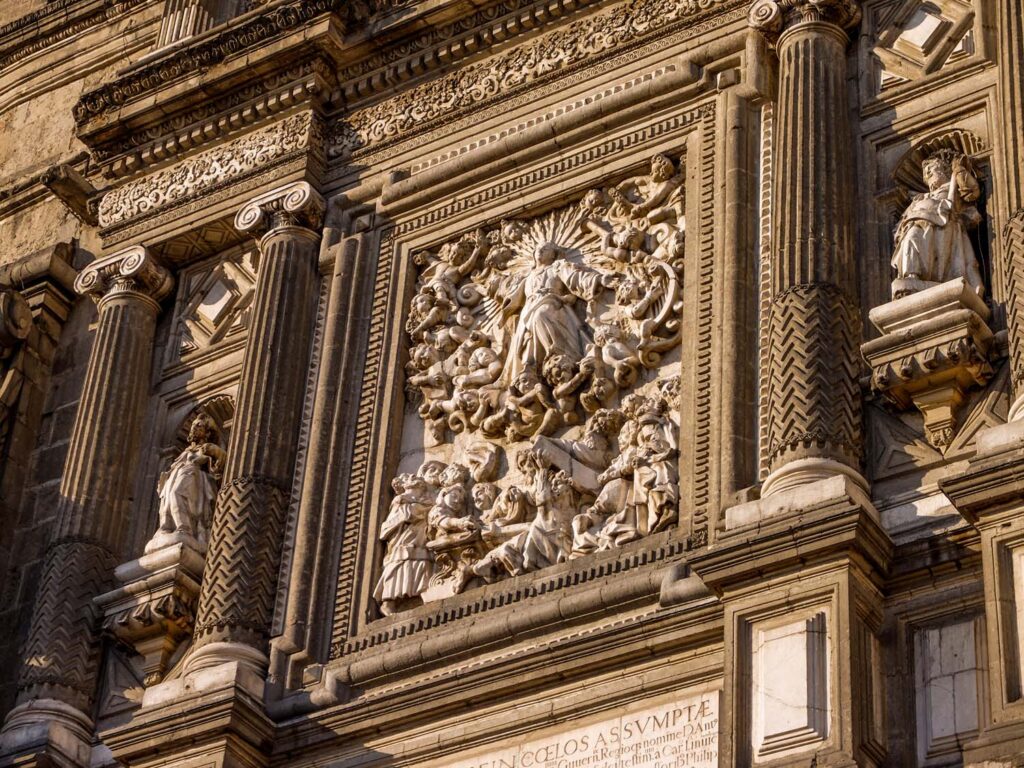
Historical Ruins
Just inside the gates of the Cathedral, lookout for a set of glass windows embedded into the ground. Peering down inside you can spot the ruins of the Aztec pyramids that have been uncovered beneath. These are the original steps that would have led Aztecs to the summit of the temple. In addition to the little window into the below-ground relics, are a series of large stones spread across the courtyard. These are remnants of the old temple of Tenochtitlan.
Bell Tower
Like Westminster Abbey or Notre Dame, Mexico City’s Cathedral has two large bell towers on either side. Originally, the church didn’t have these towers. Towers became in-vogue in the 18th century so architect and artist José Damián Ortiz de Castro and Manuel Tolsá were brought on for the new addition. The two went about designing the tower in neo-classic style with those striking bell-shaped roofs supported by tall balustrades.
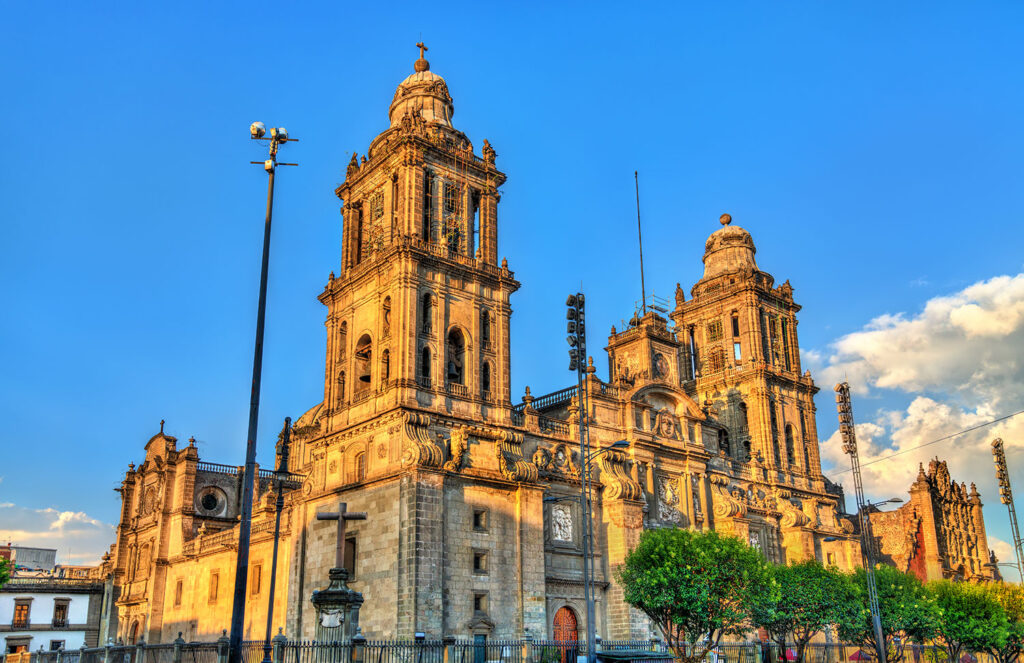
On each of the tower’s corners are statues of various individuals representing the three theological virtues. Faith, hope and charity are all represented through iconic saints and religious figures. On the west tower, these include Pope Gregory VII, Saint Augustine, Leander of Seville, St. Fulgentius of Écija, St.Francis Xavier, and Saint Barbara. On the east tower, we can see statues of Santiago Cristóbal Sandoval and depict Emilio, Rose of Lima, Mother Mary, Ambrogio, Jerome, Philip of Jesus, Hippolytus of Rome, and Isidore the Laborer.
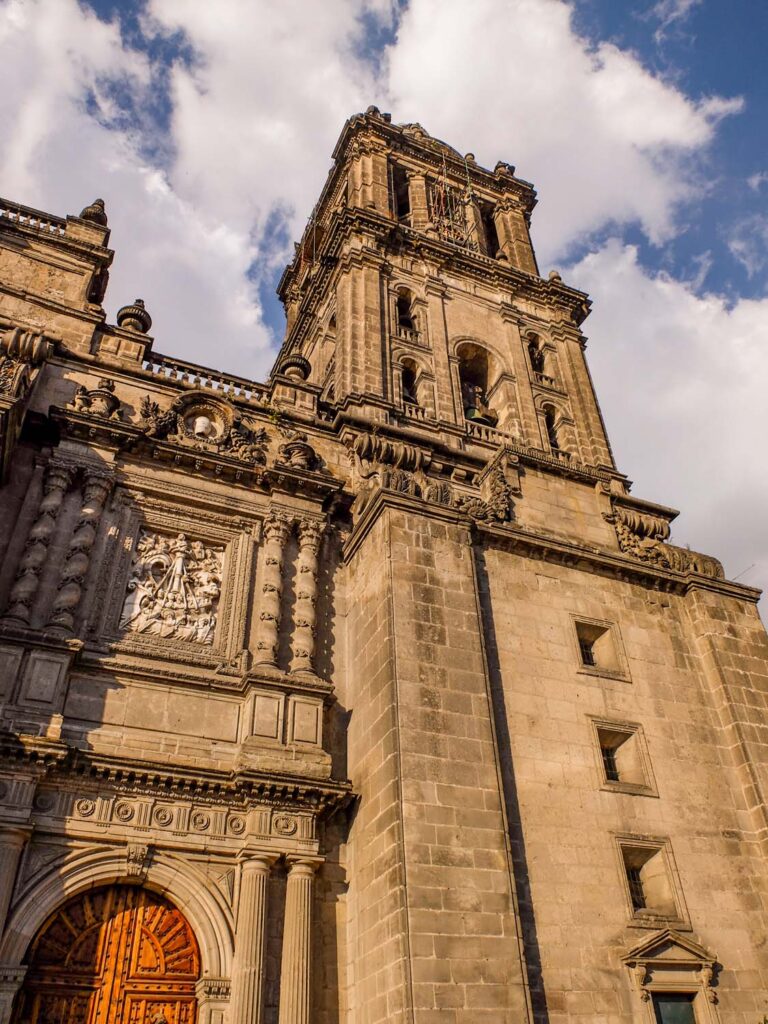
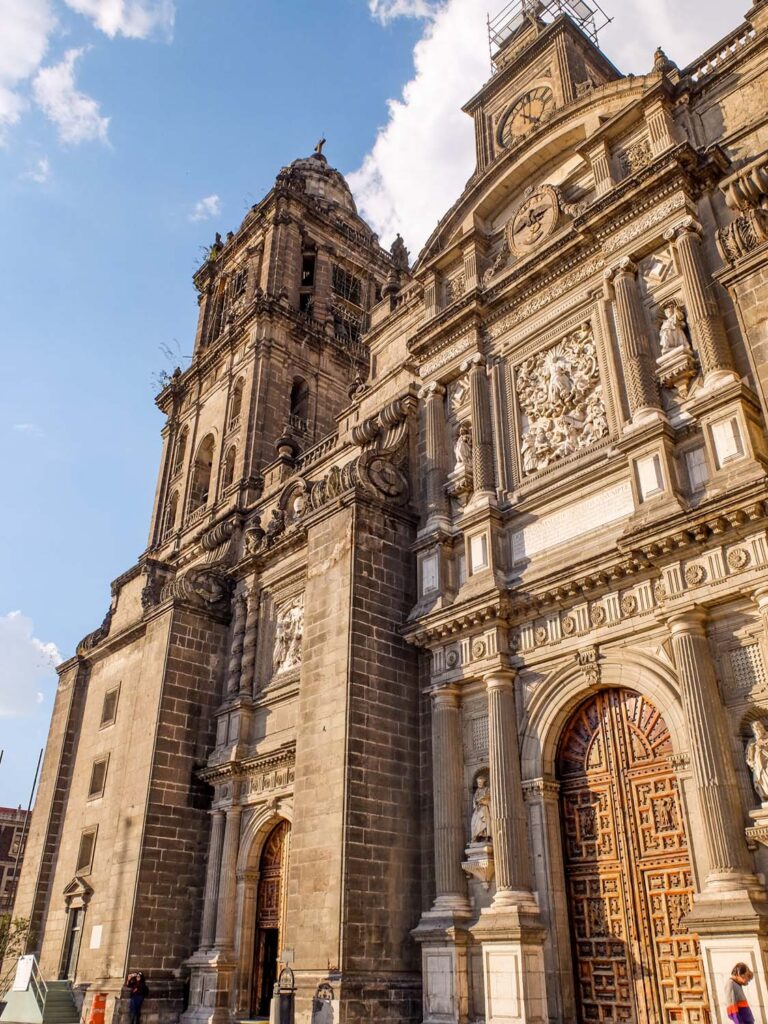
The Bells
While there are 25 bells in total, the eastern bell tower contains eighteen bells while the one in the west tower contains only seven. The largest of the bells was given the name Santa Maria de Guadalupe and weighs around 13,000 kilograms. The city seemed to love naming their bells. They call the one with the harshest tone La Ronca or “the hoarse one.” In 1947 an apprentice bell ringer died when trying to move one of the bell. It fell off its hinge and landed on top of him, killing him instantly. The bell was “punished” for this action, and had its clapper removed. This meant that whenever the bells would ring in unison, this bell made no noise. They called this ball, La castigada or “the punished one.” After 50 years, the clapper was reinstalled. Perhaps 50 years is the traditional sentence for murderous bells.
Time Capsule in the Tower
At the very top of both bell-shaped tower roofs are the stone carving of a cross set upon a large ball. During renovation works in 2007, one of the workers noticed something inside the ball on the southern tower. They opened it up and found it inside a time capsule. It turns out this capsule was placed there on May 14th, 1741!! Inside were religious artifacts, coins and pieces of parchment. Instead of removing the items, they simply added a few more things of their own. They closed up the capsule once more for the next generation to discover.
Dome
Towards the back of the Cathedral, seen best from the Zocalo, is the neoclassical Dome. The Dome was built in 1780 and the work of Spanish architect Manuel Tolsá. The Dome is designed as an octagonal drum topped by a tall, albeit narrow, lantern. The lanterns and the windows surrounding the base of the drum allow a generous amount of light into the otherwise darkened cathedral. Ionic pilasters hold up arched entablatures with central shields.
Pope John Paul II Sculpture
Just before going inside, walk down the left side of the exterior of the church. Towards the back, near the side entrance, is a fascinating modern sculpture dedicated to Pope John Paul II. Superimposed over his cloak is the image of the Virgin of Guadalupe. The Virgin of Guadalupe first revealed herself on the inside of a cape, so it is meaningful to see her once more showing herself within the robes of Pope John Paul II.
But even more interesting is the material in which the sculpture is made. Get up close to see thousands of tiny keys sticking out from the sides. These keys were donated by the Mexican people and melted down to create the sculpture. The plaque on the stone column dedicated to the Pope states that Pope John Paul II was the “key to their hearts.” The sculpture was made by Mexico City artist Francisco Cárdenas Martínez.
Interior
Walking inside, the first thing you take note of is the juxtaposition of the light and airy atmosphere and the heavy stone columns which hold up the incredible interior. The interior consists of 40 columns, 5 naves, 51 vaults and 74 arches. The central nave is flanked on either side by two processional naves which are used for important celebrations. Staring up at the ceiling you can take note of the pale green and geometric neo-classical designs by Manuel Tolsá.
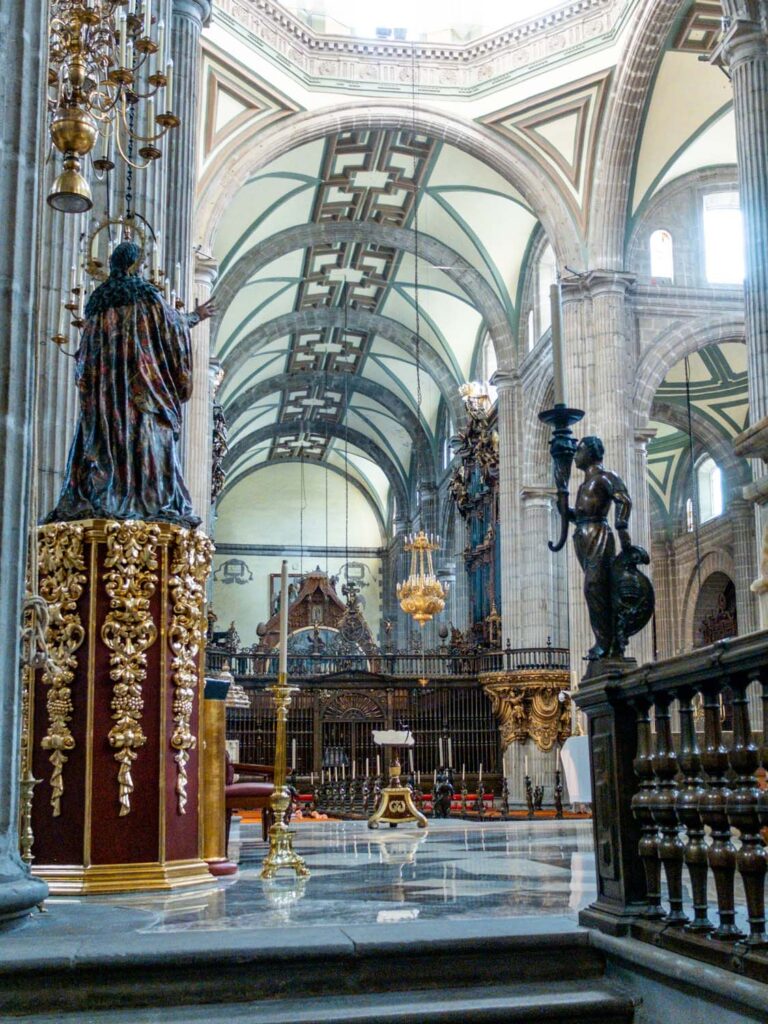
The Church Windows
Unlike many European cathedrals designed at the time, the church contains no elaborate stained glass portraying images of Saintly figures. The windows are very simple and composed of modern, geometric shapes. Irregular squares made of mostly clear but sporadically coloured glass jumble together to form the window designs. The windows were created in 1960 by Mexican-born artist Mathias Goeritz. Goeritz studied in Germany under the minimalistic influences of the Bauhaus style of art which can be seen here in these windows. The one benefit of the lack of highly detailed stained glass is that they let more light into the cathedral.
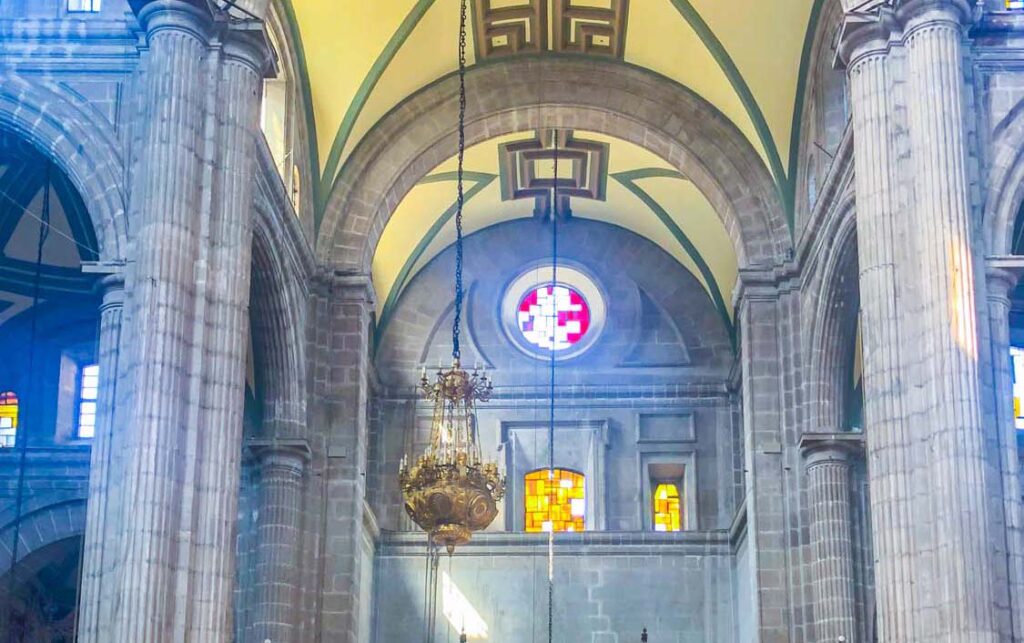
The chapels along the side aisles have no windows, as the only source of natural light comes from the clerestory and the Dome’s lantern. This results in the chapels feeling a little dark whereas the rest of the sprawling interior somehow feels incredibly bright! Such an exciting combination. It almost makes peering into those darkened chapels like trying to uncover a hidden mystery.
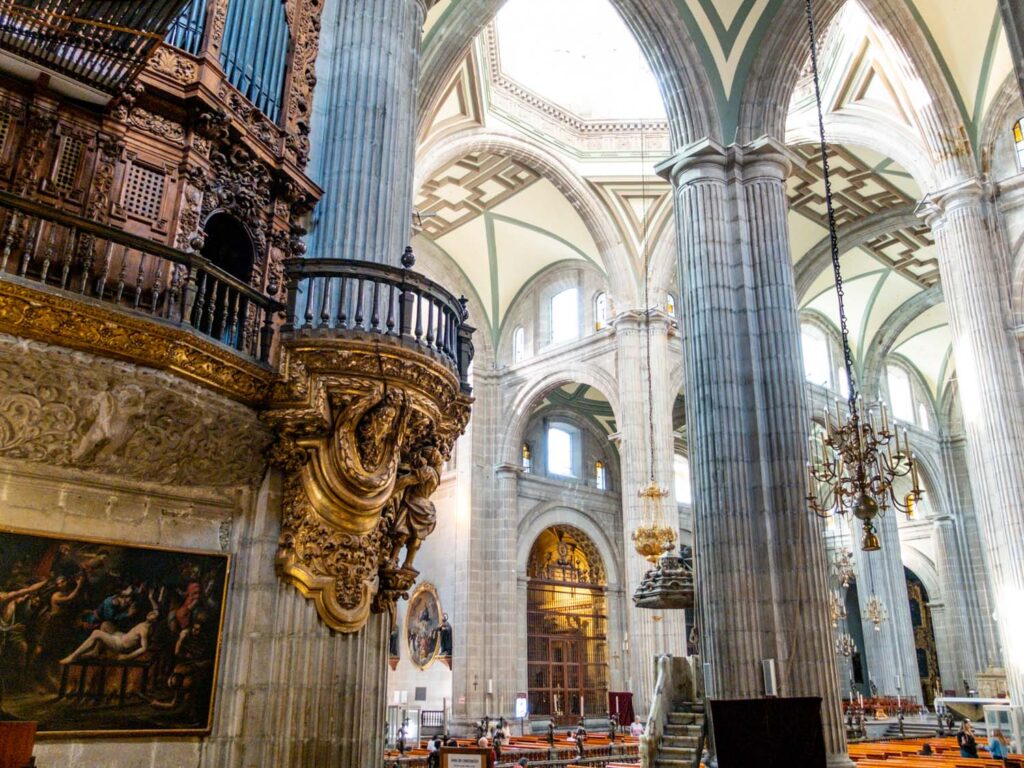
Altar of Forgiveness
The first large-scale feature you are immediately struck by upon walking inside is the golden Altar of Forgiveness. It’s rare to find an altar immediately upon walking into the church, but this church has multiple altars, of which this is just the first. The Altar of Forgiveness is absolutely stunning by the sheer volume of golden leaf that was used to cover it from top to bottom. Its semicircular arch with sculptural medallions almost looks like a piece of jewellery. Look closely at the four columns which support the altar on either side of the central painting. This was the first use of the estípite column by architect Jerónimo Balbás. The estípite column is unique to Churrigueresque Baroque architecture and is designed in the shape of an inverted cone or obelisk.

During the Spanish Inquisition, the condemned were brought to the altar to ask for forgiveness. This was done shortly before the “criminal” were sent for execution. In the center of the altar is a patining by Flemish artist Simon Pereyns of the Virgin and Child in her arms. Despite making multiple paintings inside the Cathedral, Pereyns himself was accused of blasphemy during the inquisition. To avoid persecution, he painted what was thought to be one of the most beautiful images of the Virgin Mary. For this, he was forgiven his crimes in exchange for the painting.
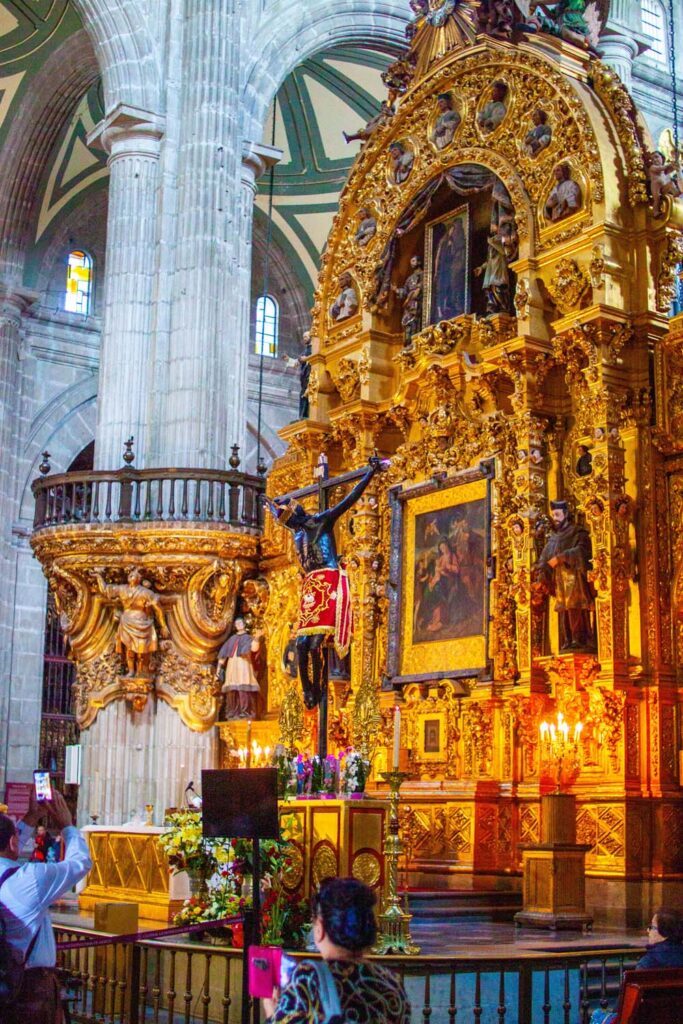
The Poisoned Lord
To the right of the altar is a large black-coloured crucifix made from sugar cane. This is a typical indigenous technique for sculpture making. The crucifix was made by indigenous artisans in the 18th century and is nicknamed the “Poisoned Lord.” Take note of the unfamiliar shape of Jesus’ body. His knees are bent off to the side in an odd pose. The legend goes that one day a guilty criminal came to the church to give his confession. He had just aimed to steal a valuable treasure but, in the process, had accidentally killed a man. After his confession, the criminal worried that the priest might turn him in. Sadly, the criminal was unaware that priests cannot break the seal of confession. Fearing for his life, the criminal followed the priest’s movements and saw that nightly the priest kiss the feet of Jesus on the crucifix.
That night after the priest went to bed, the criminal smeared poison on the sculpture’s feet. When the priest returned the next night to pray, when he went to kiss the feet, the sculpture came to life and swung his feet out of the way. Ensuring no poison got on the lips of the priest. The legs of the wooden statue have since remained in this very position. It serves as a mystically warning to any future criminals.
Continue walking down the right side of the nave to explore the chapels on the right. Depending on the time of day or time of year, the chapel may or may not be open for prayer inside. If they are not open you can still peak through the wooden gates to get a better look at the treasures and artistry inside.
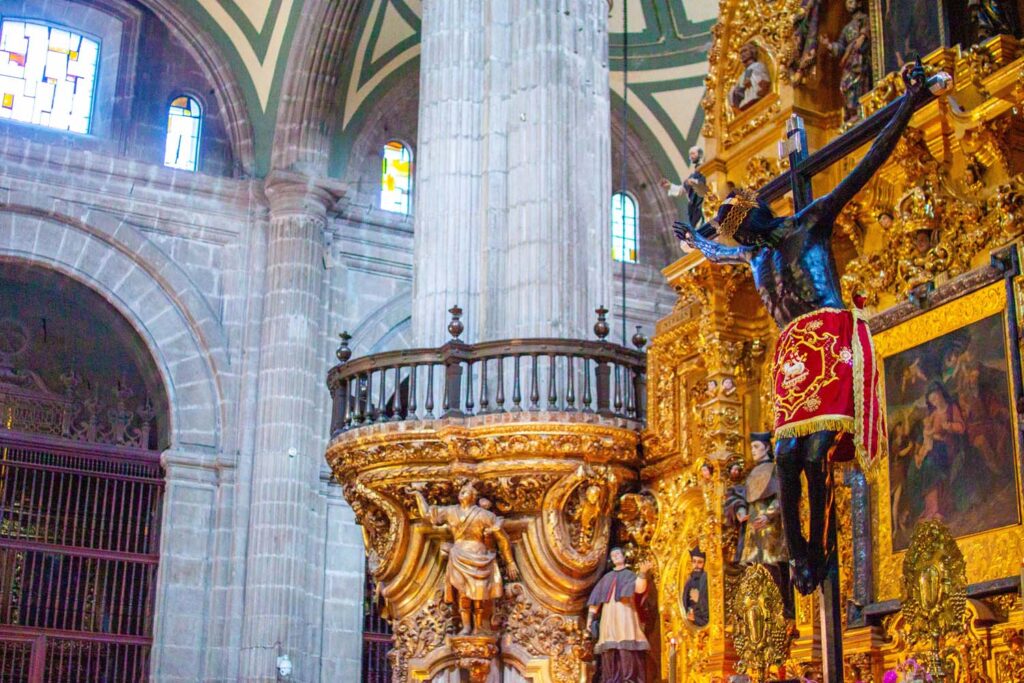
Chapel of the Immaculate Conception
The Chapel of the Immaculate Conception is the third chapel to the right of the entrance. It was originally built in 1642 but the grandiose churrigueresque altarpiece dates to around the 18th century. Surrounding the entire gilded altar are paintings inside ornate mouldings which depict the various Passions of Christ. Each of these was painted by José de Ibarra, a Mexican painter, born in Guadalajara. But the name of the Chapel comes from the delicate but striking sculpture of the Virgin Mary in the center of the altarpiece. At this moment of conception, she is free of original sin and surrounded by tiny angels with the starry halo above her head.

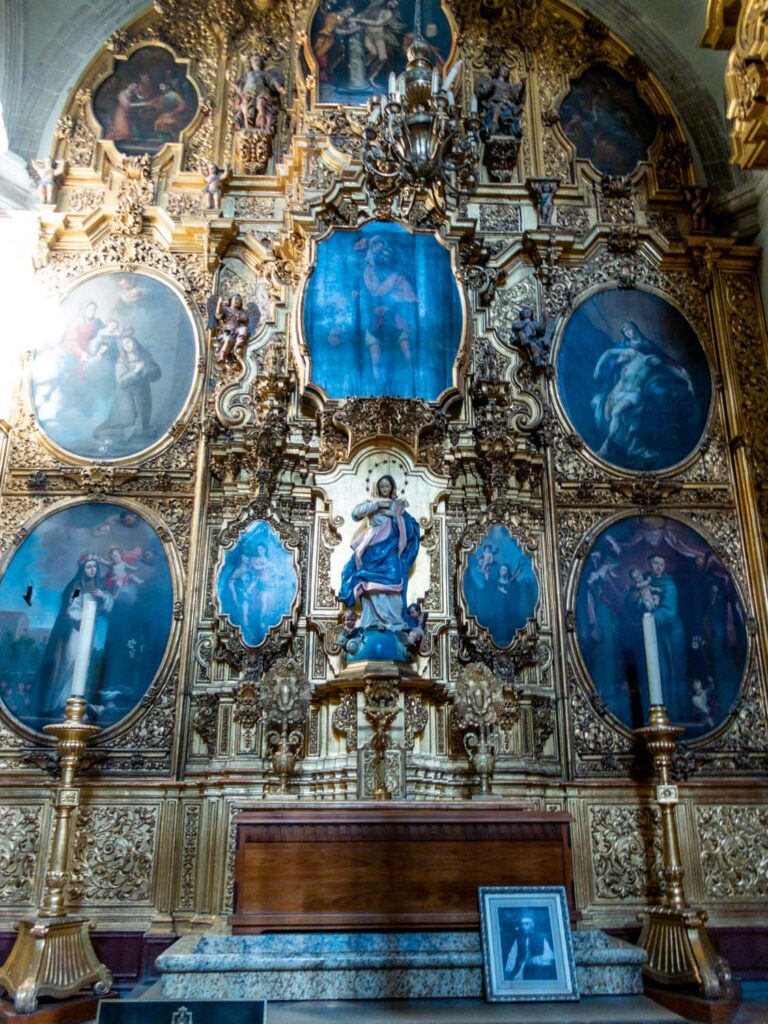
Chapel of Our Lady of Guadalupe
The Chapel of Our Lady of Guadalupe, despite it more austere appearance, is always one of the most popular for locals to visit. The area where the Chapel now stands was the original church baptistery built in 1660. The current design of the interior was made in the 19th-century following a neo-classical style. The main altarpiece is dedicated to the Virgin of Guadalupe. The painting in the center of the columns is a reproduction of the famous original found in the Church of Guadalupe.

The Story of Our Lady of Guadalupe
The Lady of Guadalupe or the Virgin of Guadalupe is the most venerated image in Latin American Catholicism. The story goes that one day a young indigenous man named Juan Diego was visited by an apparition of the Virgin Mary. The apparition spoke to Diego in the native Nahuatl language. She said to Diego she was the “mother of the very true deity.” The Virgin asked Diego to erect a church in her honour. The place where the church would be built would go on to become Villa de Guadalupe, in a suburb of Mexico City.
No one would believe Diego despite his pleading. One the fourth time the Virgin appeared she instructed him to go to the summit of Tepeyac Hill. Once he arrived she told him to pick the flowers he found there. Diego was confused, as, during this time of the year, there were no flowers on the hill. But when Diego arrived, he found beautiful Castilian roses, not native to Mexico, blooming there. The Virgin arranged the flowers in Juan Diego’s “tilma,” or cloak. When Juan Diego opened his cloak before the Archbishop, the flowers fell to the floor, revealing the image of the Virgin of Guadalupe on the fabric.
Whenever we see images of the Lady of Guadalupe she is always surrounded by a huge sunburst and a large oval depicting the cloak. The Bishop who had previously case Diego away was awestruck. The clergy immediately went about building the start of what would become the great Basilica of Our Lady of Guadalupe.
Vestibule Paintings
Above the side doors to the church on either side are huge paintings by Oaxaca artist Miguel Cabrera. These oval masterpieces hang in the vestibules bringing a little bit of flair to these otherwise empty spaces. But it’s great to see more examples of Mexican artists throughout the Cathedral.

Organs
Just behind the Altar of Forgiveness, on either side of the choir, are two enormous musical organs. The original organ installed in the church was brought here from Spain in 1530. This one was relatively small for the then-midsize church. As the church continued to expand, there was a need for a more prominent organ to spread the sound throughout the church. But it turns out, one wouldn’t do the job, they needed to install two! The first organ was brought to Mexico City from Madrid in 1680. The second organ was made locally and installed in 1736. Even today, these great organs are the most significant 18th-century organs in the Americas.
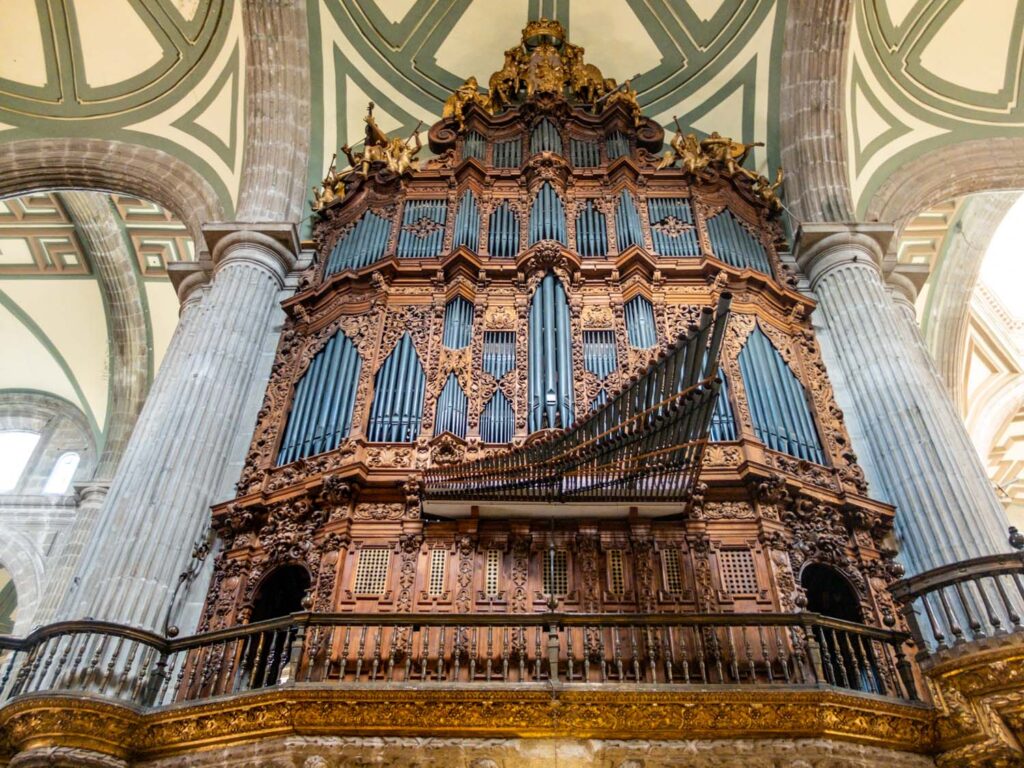
The two organs are called the Evangelio and Epistola organs. Together they can produce more than 400 vibrations per second! Hearing music inside this cathedral is truly something not to be missed if you have the chance.
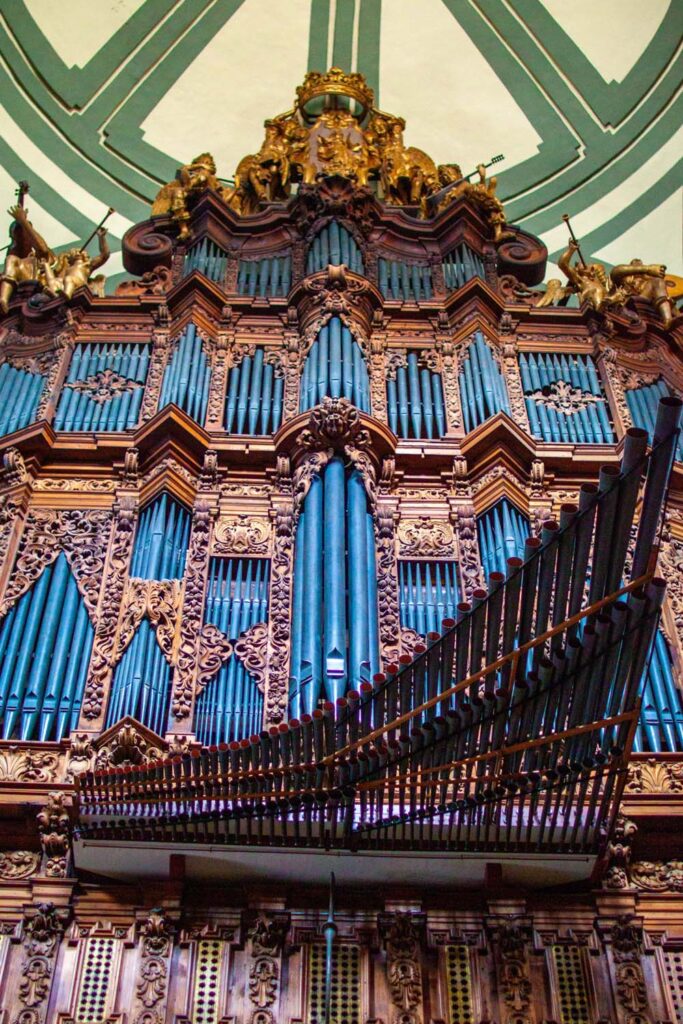
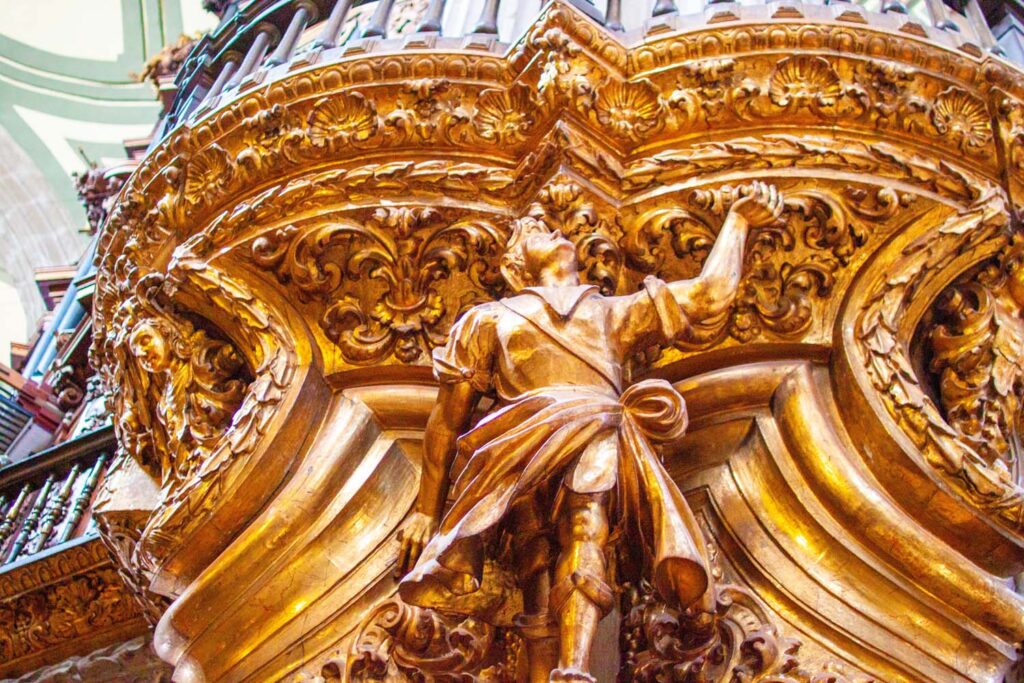
Choir
The Choir is located inside large stone walls in between the two side organs. A choir is the area of a church that provides seating for the clergy and the musical choir. The choir contains 59 chairs. Each one is precisely carved with reliefs of various saints done in mahogany, walnut, cedar and a native wood called tepehuaje. Above the choir walls is a great painting of Jesus surrounded by angels. This is designed in a semicircular arch, a style popular in Spanish Cathedrals of the time.
Separating the Choir from the nave is a beautifully carved railing that was made in China in 1730. One of the small details I love is the gigantic golden capitals surrounding the columns on either side of the choir. Inside the designs, you can spot images of men intertwined with the foliage who look like they are holding up the large columns themselves. Sitting in the middle of the choir is a large mahogany lectern. In the very top portions, there is a statue of a tiny ivory crucifix that crowns the singing books found within the four sides of the lectern.
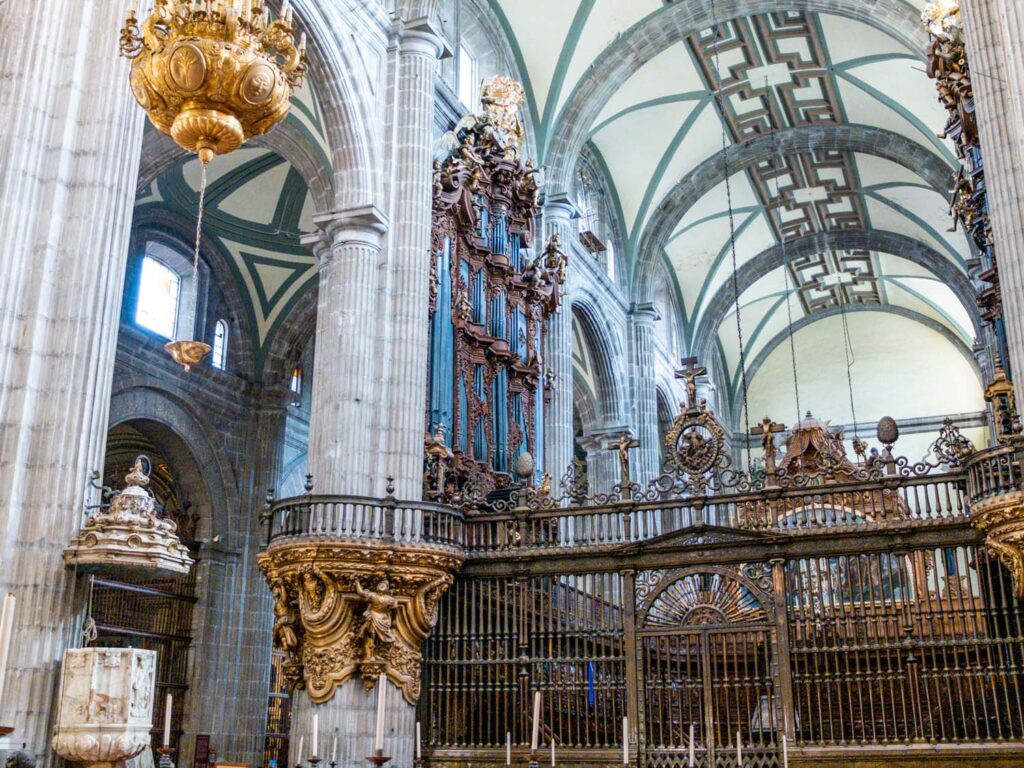
Central Nave & Pews
Joining the choir to the main altar is a large passageway, separated on either side by beautiful bronze balustrades. Set into the balustrades are a series of anthropomorphic figures holding torch sockets used to light the cathedral at night. The flooring here is decorated with bright green, red and pink marble tiles distinguishing itself from the pale stone on the floor of the rest of the Cathedral.
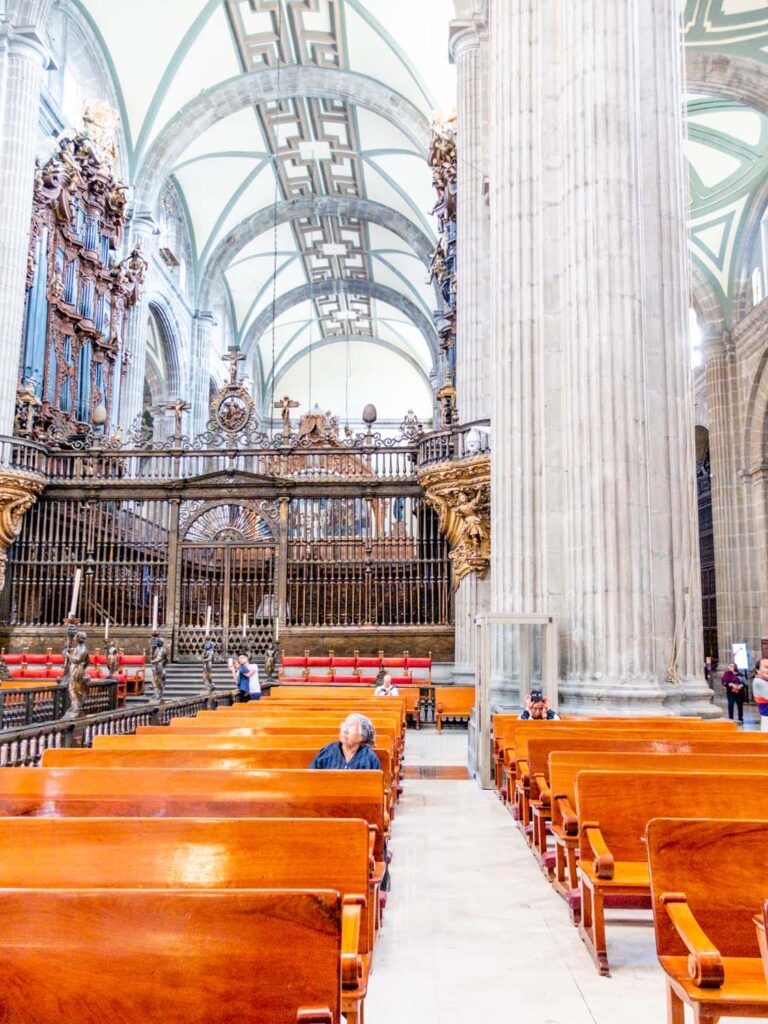
Pendulum
Since the Cathedral was built on soft soil, despite all the architects’ best efforts, the building is indeed sinking. It sinks on average three feet per year! But even more confusing is that it is sinking unevenly. Which is much more dangerous to the structural foundation. In the central aisle, between the pews, a giant pendulum swings from the rooftop. On the floor, you can see a stone plaque, which marks the tilt and shift of the church over time. Various dates mark down precisely the angle and depression of the church during those periods.
Major Altar
Towards the end of the nave is the Major Altar. Unlike some churches, the main altar here is open to the rest of the building, like a floating platform. Atop the stone platform is another huge piece of beige marble where the priest prepares the eucharist. The altar is surrounded on all sides by vast alabaster columns with eight giant candelabras descending down from the ceiling. On the front corners facing the pews in the nave are two huge marble pulpits with rudimentary carvings.
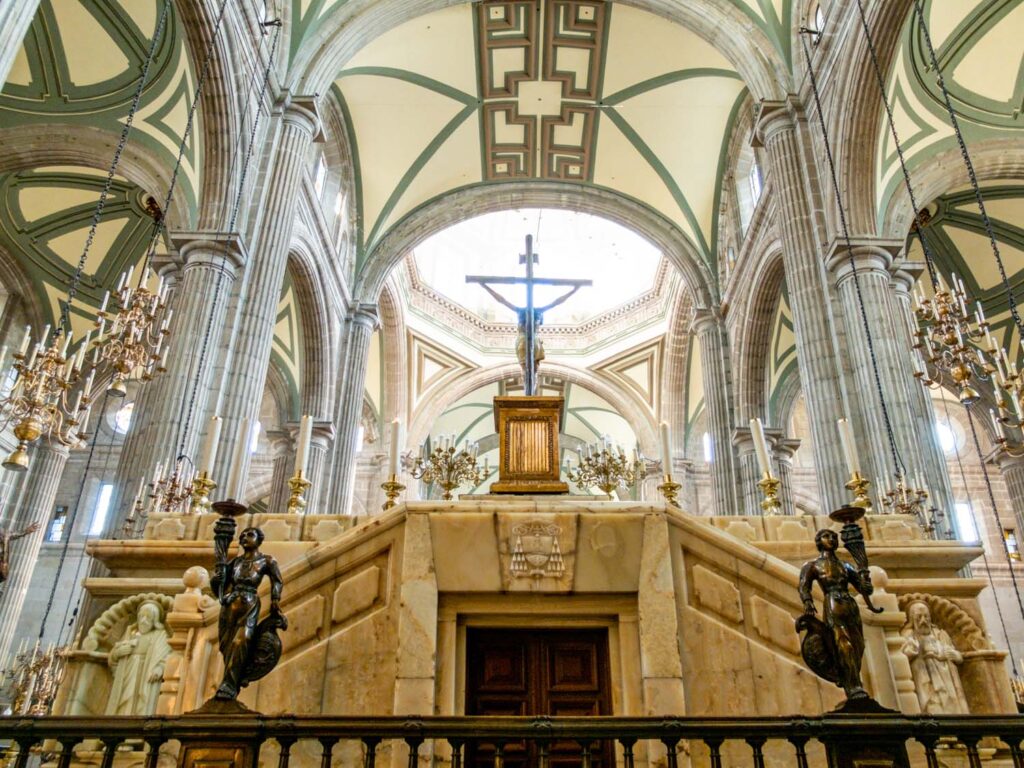

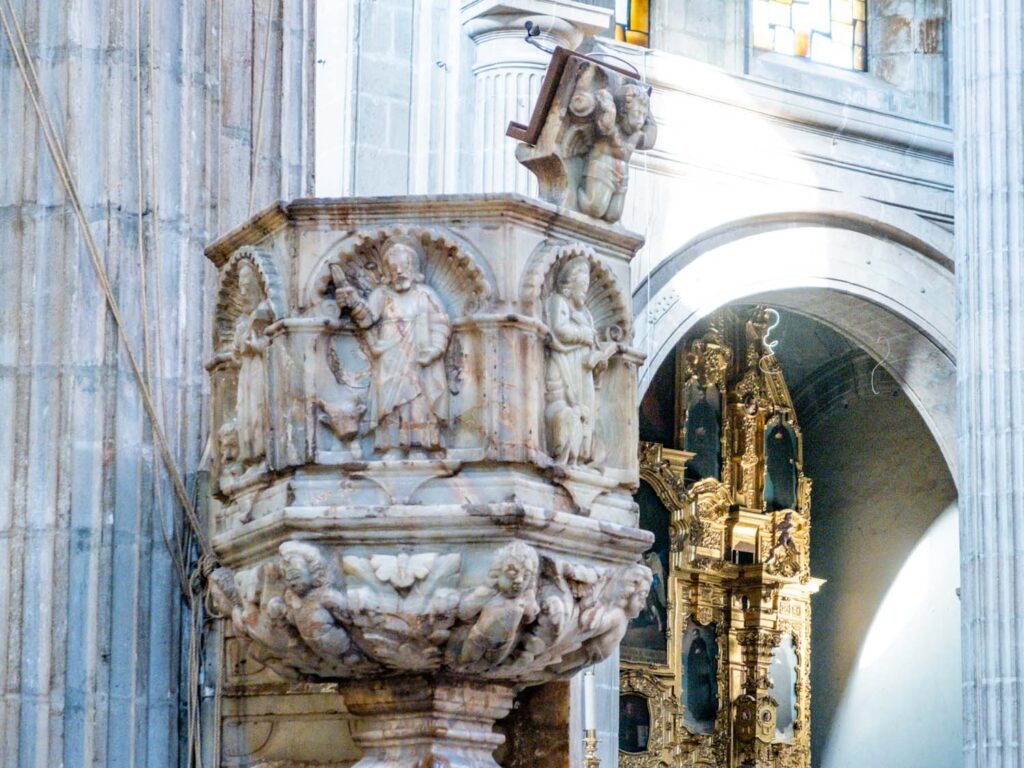
Chapel of Saint Peter
Head back to the right side nave to the Chapel of Saint Peter. This chapel was built between 1615 and 1620. Inside, the chapel contains three highly decorated Baroque altarpieces from the 17th century. These are each divided by the most ornately carved columns. The columns are so densely covered with foliage that they look almost like they are overtaken by the growth. Your eye struggles to find a focal point in this mesmerizing room. Over the main altar, encased in glass, is the sculpture of Saint Peter. Surrounding him are paintings by Spanish painter Baltasar de Echave Orio depicting crucial moments from Saint Peter’s life.
In a small glass case below Saint Peter, is the encased image of the “Niño Cautivo” or “Captive Child Jesus.” This little sculpture was made in the 16th-century, and despite its diminutive status, it holds a great history. When it was first carved in Spain and sent to the new world, the ship on which it travelled was attacked by pirates. The sculpture was so important to the church that they paid off the ransom demanded by the pirates. Once the money was paid, the sculpture was returned to the church. The Niño Cautivo‘s dramatic capture and eventual release helped grow the legend and lore around the work of art.
Today, people who find they are “trapped” either financially or by addiction come here to pray for their own “release.” Other people take the “Captive Child” idea literally, and anyone who has had a loved one abducted comes here to pray for their literal release.
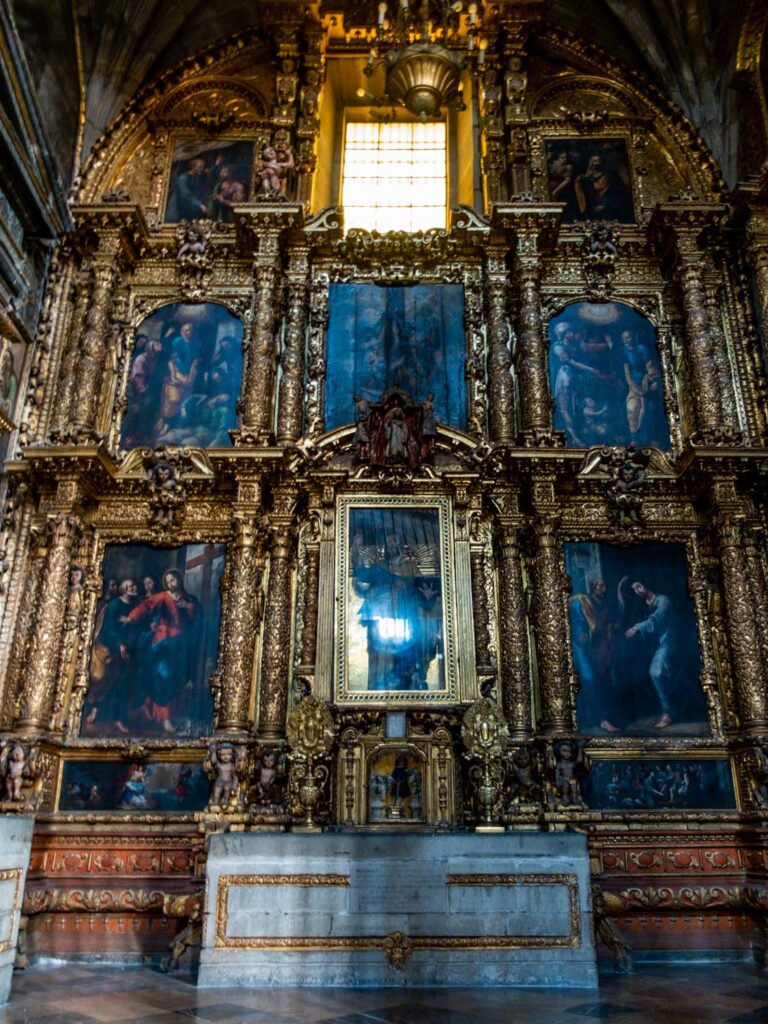
Chapel of the Reliquaries
My favourite of all the chapels is the Chapel of Christ and of the Reliquaries. This one was designed in 1615 in ultra-baroque fashion. There is not a single inch of the walls inside that are not absolutely adorned in elaborate details. Carvings, sculptures and even the lighting are all dripping in gold. Only one small window casts natural light into the room so you really need to squint to make out the details inside the darkened interior.
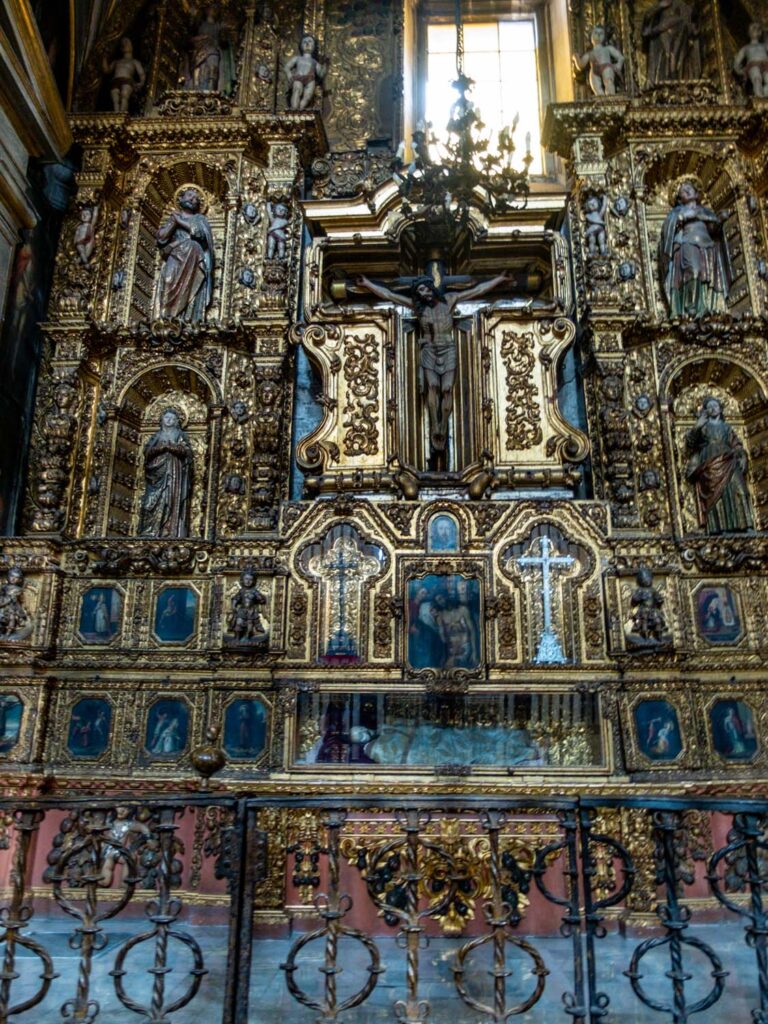
Holy Relics
A reliquary is a container for holy relics. Relics could be the actual physical remains of saints, such as bones or even preserved organs. They could also be pieces of clothing or some object associated with saints. The collections of these religious reliquaries began when Emperor Charles V donated an image of Jesus to the Cathedral. the reliquaries are hidden behind each of the little painted compartments. When opened up you can find little shrines inside. The relics contained inside relate to San Vicente de Zaragoza, San Vito, Santa Úrsula, San Gelasio and San Vital de Milan. Most importantly is the splinter of Vera Cruz and a crown spike from Jesus himself.
On the bottom of the altar is a glass case containing a sculpture of the “Holy Burial.” This piece is used every year in the Good Friday procession. While most of the time the relics are hidden away, if you’re lucky, you can see them exhibited on All Saints Day (November 1 and 2).
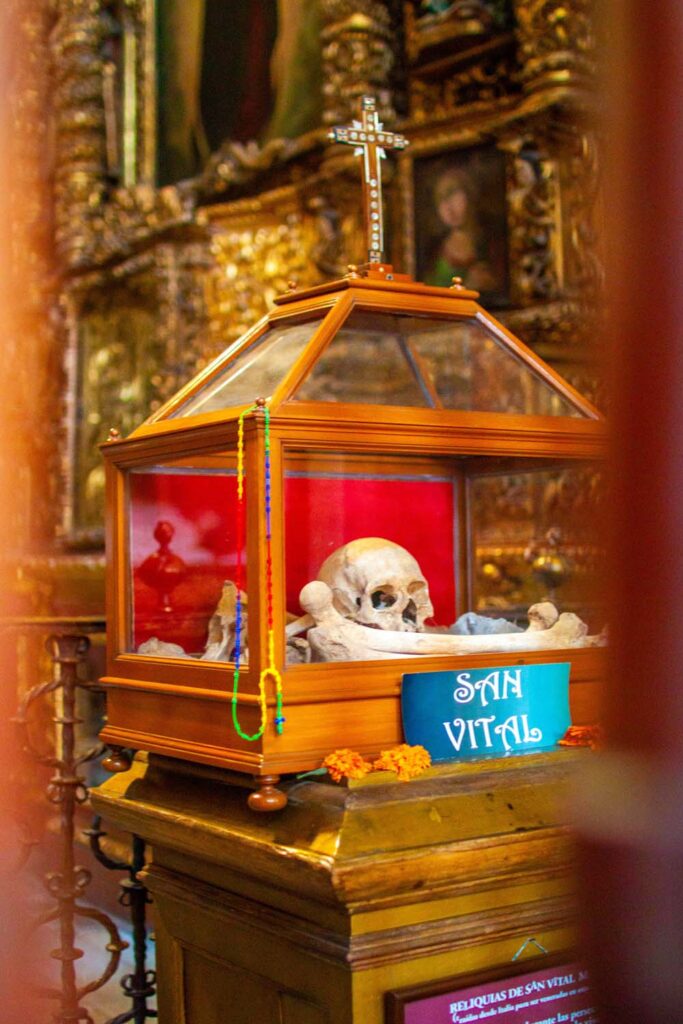
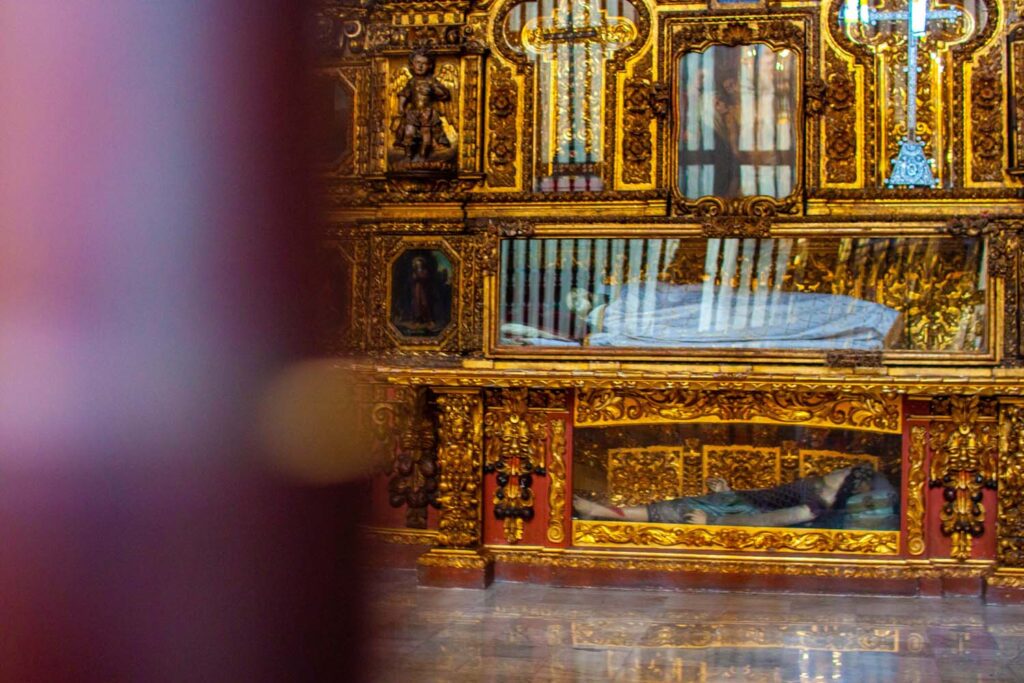
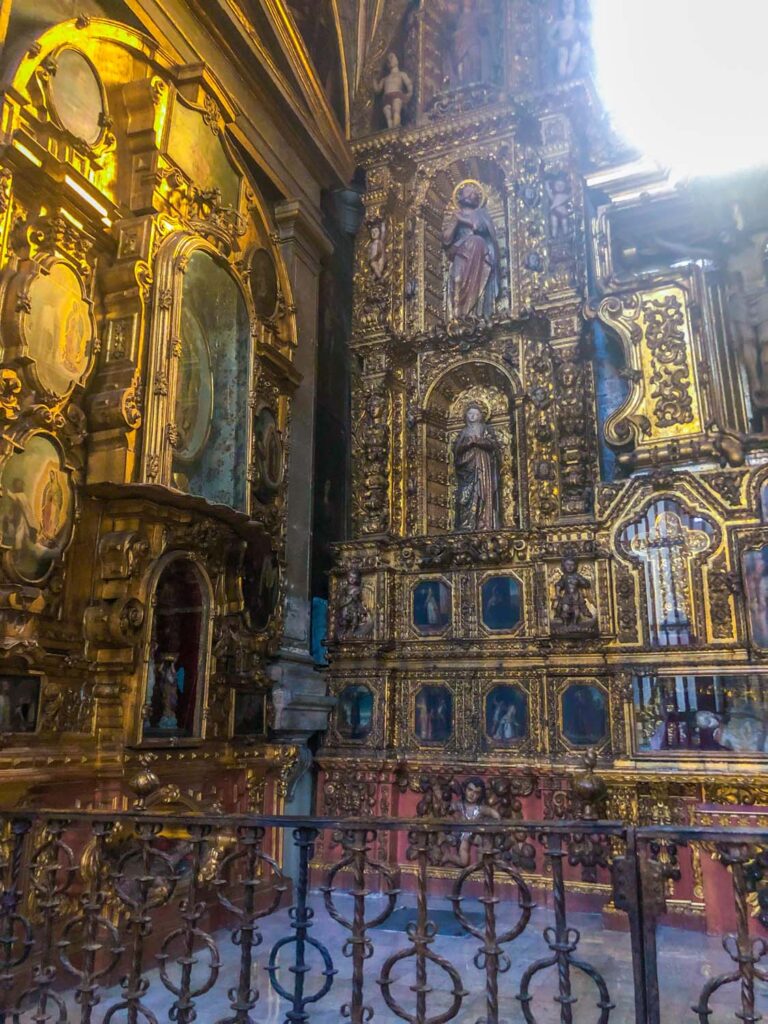
Sacristy
Hidden behind the greatly decorated doors is the Sacristy. The Sacristy is not always open, so look for the doors to be opened to enter this area. This part of the Cathedral is the oldest part of the building. The enormous mahogany doors contain images of strength and greatness depicted by hundreds of symbolic carvings. From the keys of Saint Peter to the sun (a symbol of God in ancient Mexican culture), images of arches, cities and of course, the crown of God.
Mural Paintings
Walking inside the first thing your eyes will be drawn to are the enormous murals covering the walls. These paintings were made by Cristóbal de Villalpando. Each of these scenes is a collage of a multitude of religious events. From the Apotheosis of Saint Michael, The Triumph of the Eucharist, The Church Militant and the Church Triumphant, to The Virgin of the Apocalypse. Despite the enormity of the characters and different landscapes the pieces are all drawn together by the use of a common autumnal hue.
On the opposite side of the wooden gate, is the area for prayer to the left of the entrance. Inside this section, there is a glass case with a beautiful ivory sculpture of Christ on the Cross. Take note of the beautiful gothic vaulted ceiling with gilded flowers on the crown mouldings used throughout the Sacristy. Directly above this area is a small window with a painting of God and the father descending down towards us. The mural is painted in such a way to make the image look three dimensional, as if at any second the painting would come alive.
Treasures
Included in the original treasures of the Sacristy was Juan Diego’s cloak. It was upon this cloak that the image of the Virgin of Guadalupe once appeared. But after massive flooding in 1629, the cloak was removed from the Sacristy to better protect it. Inside the wooden cupboards around the room are gold chalices, glasses trimmed in fine stones, sacred vessels, and gold and silver candlesticks.
Altar of the Kings
At the back of the church is the massive golden Altar of the Kings. The decorative altar is covered from floor to ceiling in rich ornamentation and expensive gilding. The 13-meter tall altar also goes by the nickname la Cueva Dorada (“the golden cave”). The altar stretches up so high, it creeps up on the domed ceiling, creating that cave-like effect. That in addition to the fact that there are no windows allowing light into the tightly packed space. Peering out from every corner of the altar are skillfully carved statues of saintly royalty. The entire work of art took over 19 years to complete! It was begun in 1718 by artist Balbás and finished by Francico Martínez. Although honestly, with the sheer magnitude of works of art contained within, you’d be surprised it wasn’t longer.
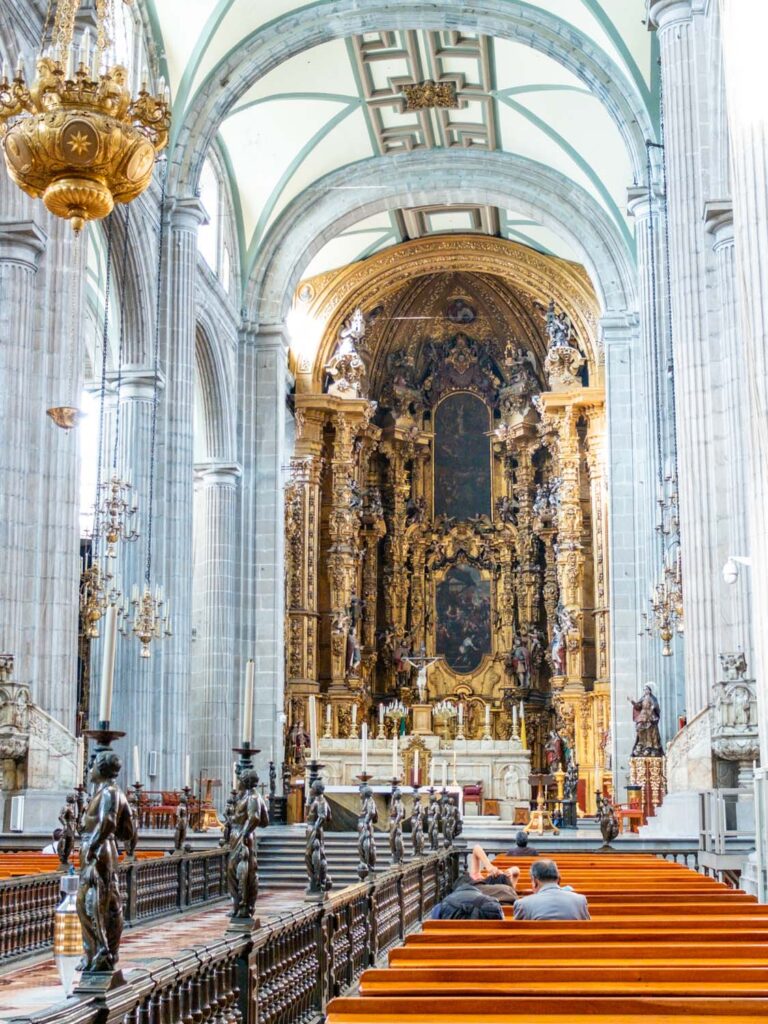
Royal Saints
Towards the bottom of the altar are the collection of female royal saints. Saint Margaret of Scotland, Helena of Constantinople, Elisabeth of Hungary, Elizabeth of Aragon, Empress Cunegunda and Edith of Wilton all stand on little plinths emerging from the altar. Their billowing robes are ornately detailed and contain intricate patterns. Giving us some insight into how the royals saints would have dressed in the early Renaissance.
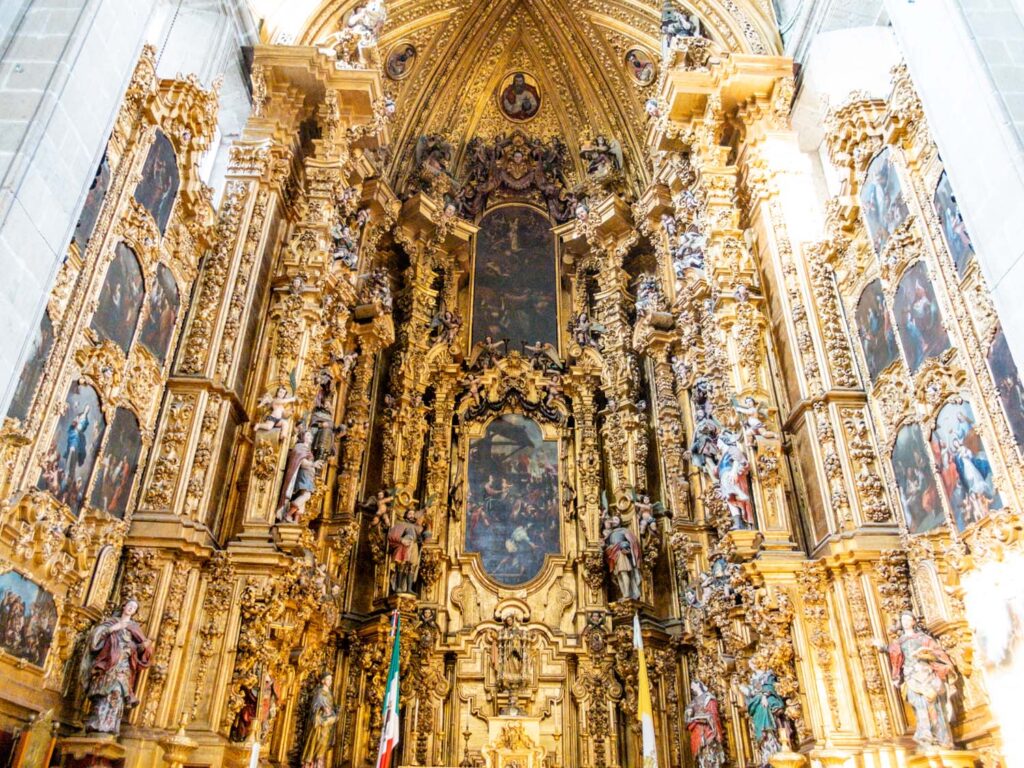
In the middle of the altar are six of the canonized kings. These include Hermenegild, a Visigoth martyr, Henry II, Holy Roman Emperor, Edward the Confessor and Casimir of Poland and the Saintly kings Louis of France Ferdinand III of Castile.

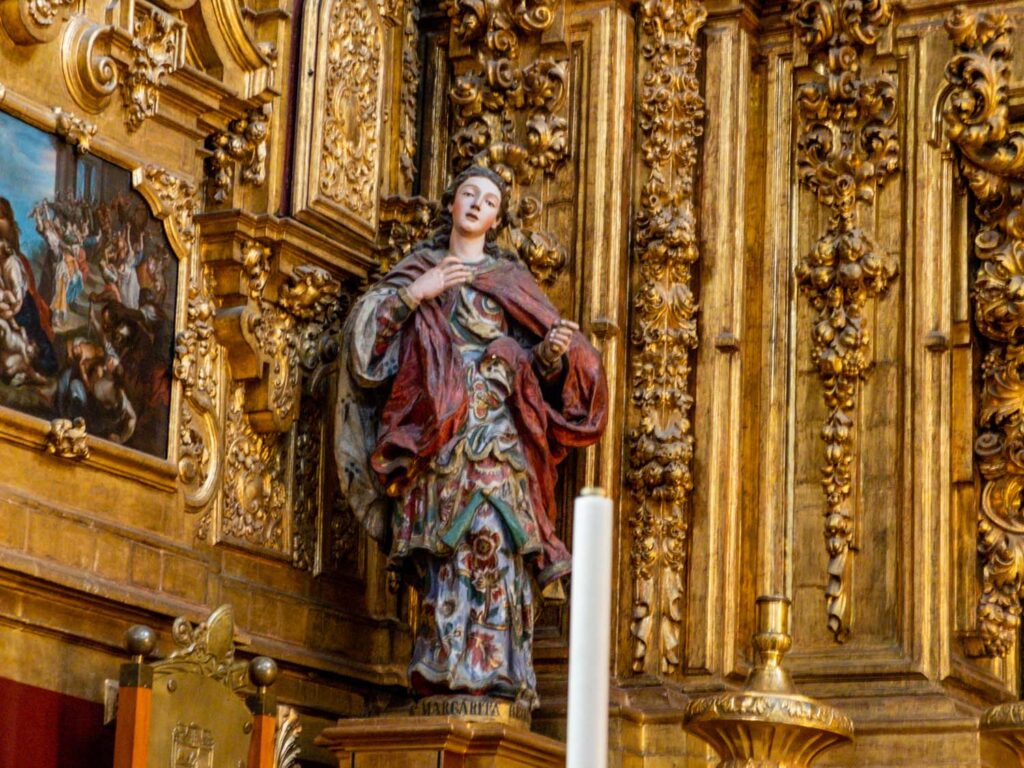

Adoration and Assumption
In the center of the altar is the oil painting of the Adoration of the Magi by Juan Rodriguez Juarez. In the scene, you can see Mary holding baby Jesus. On the steps is one of the Magi with a servant holding open a chest full of his gift.
The top portion features a painting of the Assumption of Mary. She is featured as the celestial queen in the skies. Above the painting are various carved figures of angels. On the domed roof are a series of three medallions with the image of God the Father in the center. On the other side are two similar-looking men, representing the “Son” and “Holy ghost” to form the Holy Trinity.
In the galleries on the east and west side of the Altar are a collection of paintings depicting scenes from the martyrdom of the various saints carved into the altar.

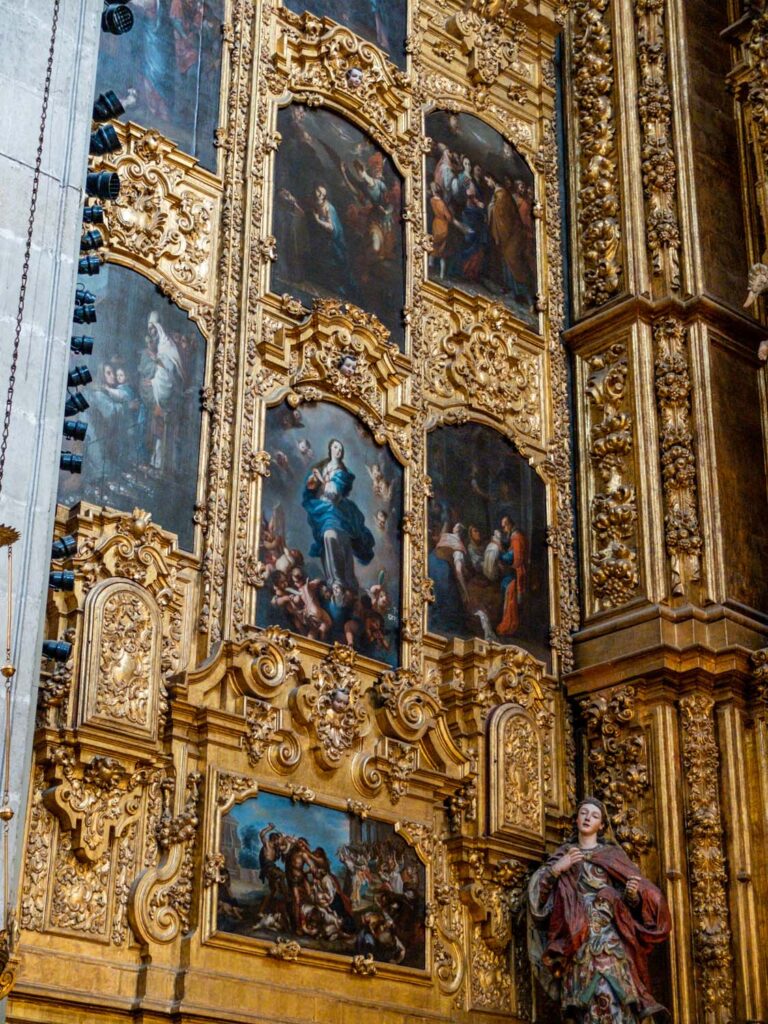
Philip of Jesus Chapel
Make your way back towards the entrance, this time walking along the left side of the nave. On the far end we find the Chapel of Saint Philip of Jesus. Philip of Jesus was the first Mexican Saint, born in Mexico City in 1572. Philip joined the Reformed Franciscans order and eventually travelled to Manila, a Spanish colony, where he continued to practice. When it came time for him to be ordained, Philip had to travel back to Mexico, as there were no bishops in Manila. But the ship that he boarded was set off course during a storm and landed on the coast of Japan.
At the time, many religious orders travelled with soldiers just for daily protection. But the Japanese took their ship filled with soldiers as a sign that they were trying to invade and conquer the land. All the men were imprisoned and eventually put to death on a mountain near Nagasaki city, which came to be known as “Mount of the Martyrs.” They were bound upon crosses and pierced with spears.
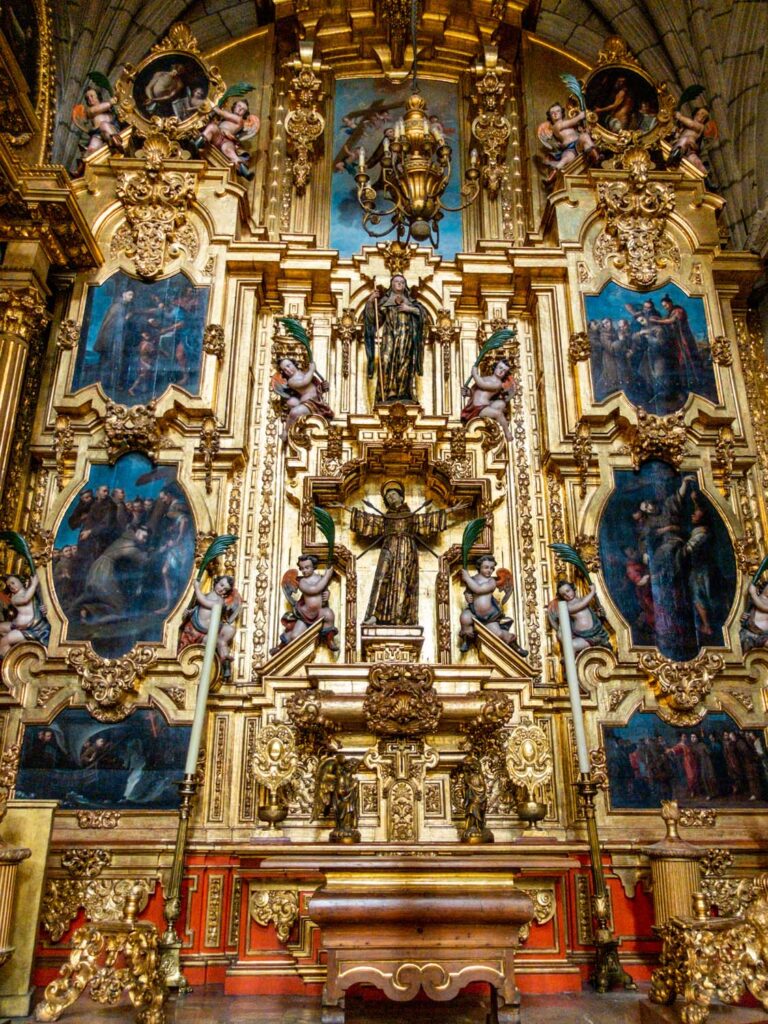
Philip’s Altarpiece
As Philip was the first Mexican martyr, his Chapel was one of the earliest ones built for the new Cathedral. It is done up in high gothic style with a domed roof and Baroque altarpiece. A statue of the Saint can be found in the niche. His arms are outstretched and the spears which led to his death stand behind him in the shape of an “x.” Many art critics consider this carving to be the best-carved sculpture from Latin America. On either side of the altarpiece are paintings of the life of Saint Philip. I love how each of the paintings is framed in a different shape. Look at the top right corner, where you can see the Japanese soldiers preparing Philip for his crucifixion. The fact he was crucified just like Jesus is what gives him the name Philip of Jesus.

Mexican Figures
Since Philip is such an essential Mexican saint, his Chapel also contains several other important Mexican figures. This includes an altar dedicated to Saint Rose of Lima, considered the protector of Mexico City. The 4th president of Mexico City, Anastasio Bustamante, also has his heart preserved here in the Chapel.
Agustín de Iturbide
Just below the altar is a large glass urn containing the remains of Agustín de Iturbide, who briefly ruled Mexico from 1822 to 1823. Iturbide, also known as Augustine of Mexico, was a Mexican army general and politician. During the Mexican War of Independence, he and his military coalition gained independence for Mexico. After which Iturbide was proclaimed President and Emperor of Mexico.
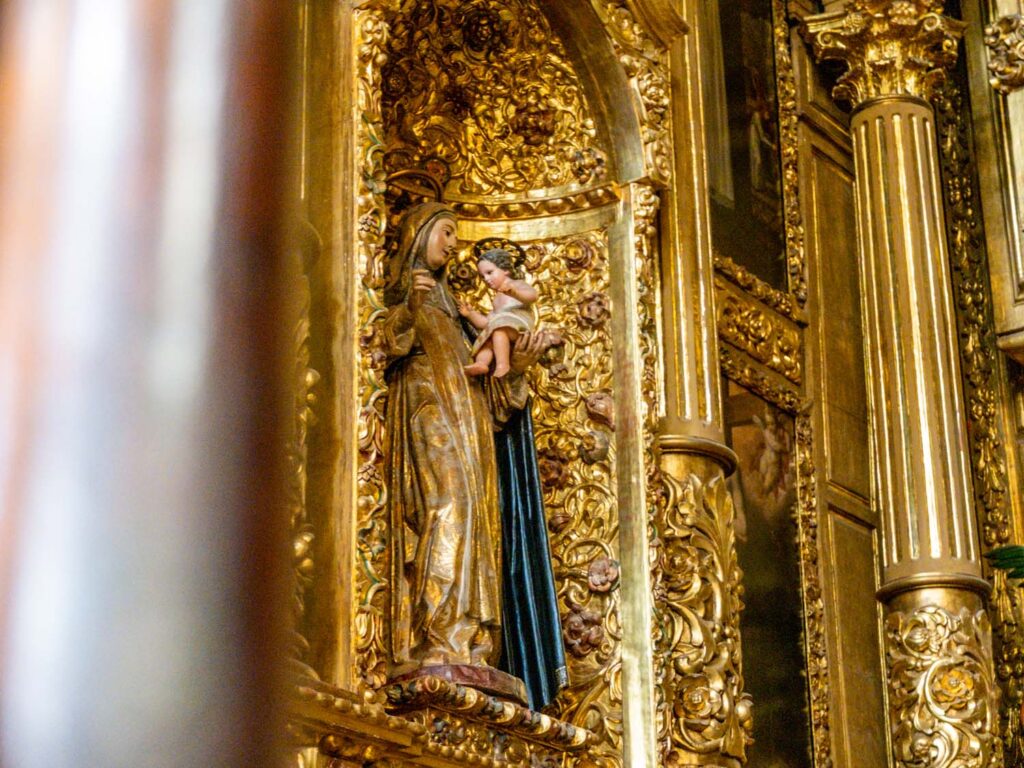
During this time, Iturbide gave the country its official title as “Mexico” instead of the “United States of Mexico.” He also designed the Mexican flag still used today. The Emperor of Spain was furious with the insurgency he saw and as revenge, he closed off trade with Mexico. This financially ruined the Nation since many of Mexico’s trading partners were still under the control of the Spanish Empire. Iturbide couldn’t pay for his army, and the government eventually turned on him. Only a few years after becoming the President, he was forced out of his position. Iturbide went into exile in Europe and when he returned to Mexico, he was arrested and eventually executed.
Today his tomb in the Chapel has the following statement written up: “AGUSTÍN DE ITURBIDE. AUTHOR OF THE INDEPENDENCE OF MÉXICO. COMPATRIOT, CRY FOR HIM; PASSERBY, ADMIRE HIM. THIS MONUMENT GUARDS THE ASHES OF A HERO. HIS SOUL RESTS IN THE BOSOM OF GOD.”
Philip of Jesus Font
In front of the entrance to the Chapel is a large stone font contained within an ornate cage. This is believed to be the baptismal font in which Philip of Jesus was first baptized.
Chapel of San José
The last chapel we are going to stop to visit is the Chapel of San José. Next to the chapel, you’ll see a large collection of ribbons tied to a wooden stand. It is believed that a woman who leaves a ribbon with a personal message to the Saint inside the Chapel upon it will stop any gossip about her. Considering the number of ribbons, it seems that gossip is still a big problem for people today!
Sagrario Metropolitano
Stepping back outside, we are now going to head over to the red brick part of the Cathedral; the Sagrario Metropolitano. While the Cathedral’s interior is much more impressive, I prefer the Sagrario Metropolitano facade more than the main Cathedral. The Sagrario Metropolitano was made originally to house the archives and vestments of the Archbishop. Today it acts as a place to receive Eucharist and register parishioners when the main Cathedral is busy with tourists. This place feels more like the everyday church for the locals.

The design of the Sagrario Metropolitano’s facade is considered one of the great masterworks of Churrigueresque. Churrigueresque is also known as Ultra-Baroque architecture. Churrigueresque architecture is defined by the elaborate sculptural and ornamental stucco work done in the mid-18th century. The style is expressive, florid and almost extreme in the detailing and decoration.
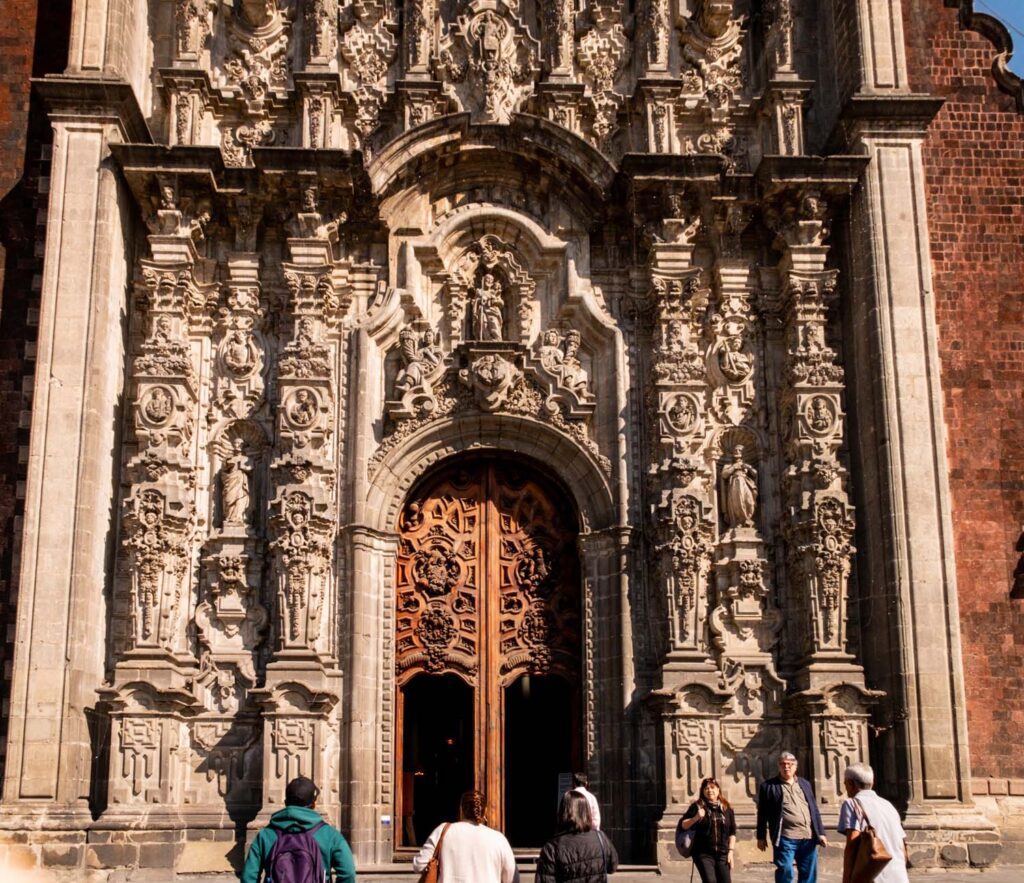
The facade of the building is reminiscent of the design of the Altar of the Kings. Tying the two spaces together. In addition to the statues, the front is adorned in floating draperies, flying cherubs and carvings of grapes and pomegranates. Admire floral elements like roses and daisies, as well as some flowers native to Mexico. Statues on the exterior represent the apostles, various saints and Martyrs, but they also contain unique zoomorphic reliefs. These reliefs include a rampaging lion and the eagle from the coat of arms of Mexico.
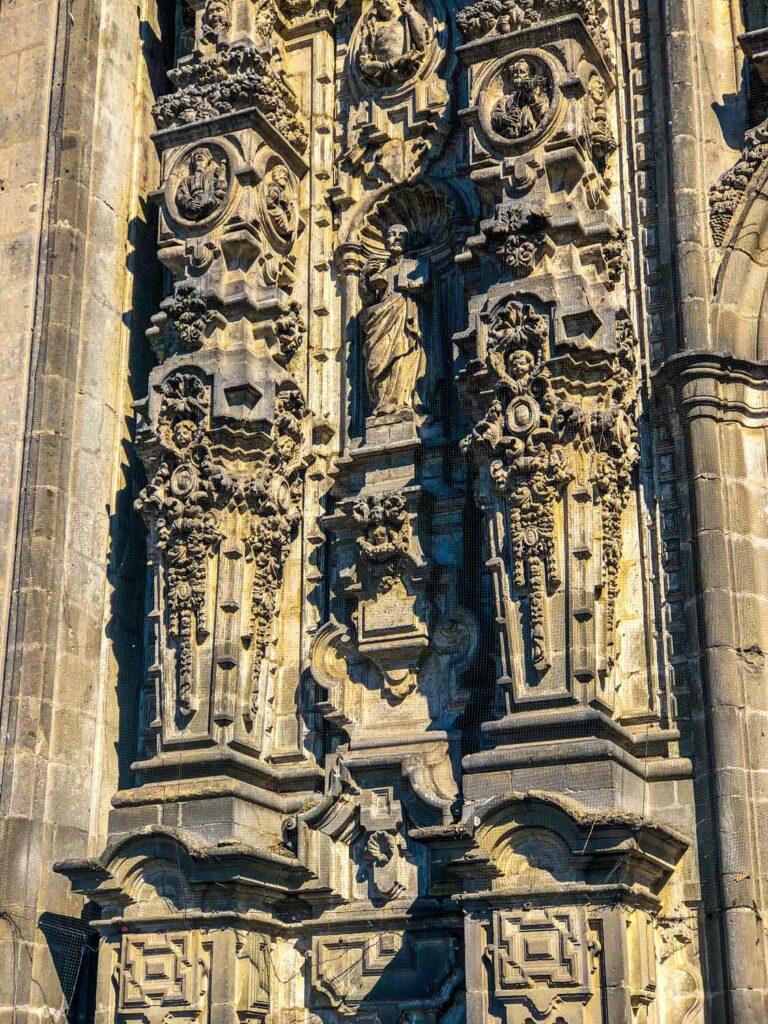

This brings us to the end of our in-depth tour of the Mexico City Cathedral. Hopefully, by walking through this tour, you learned a little bit more about Mexican architecture, venerated saints and even a look into the complex history of religion in Mexico. Let me know in the comment any and all questions you have on this wonderful place, and I will do my very best to answer them!
Happy Travels, Adventurers!
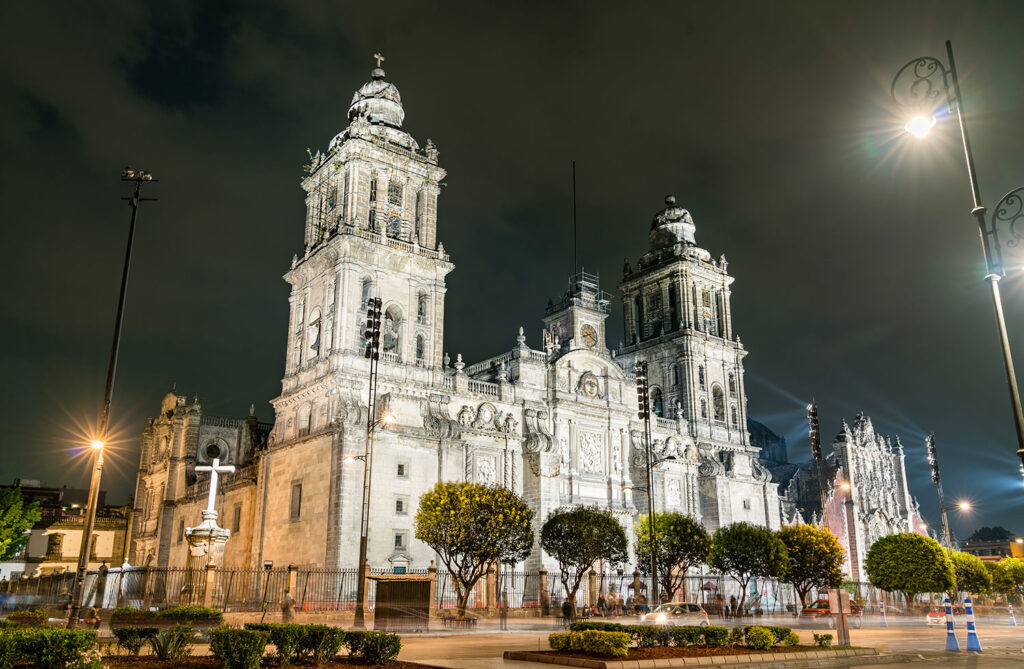
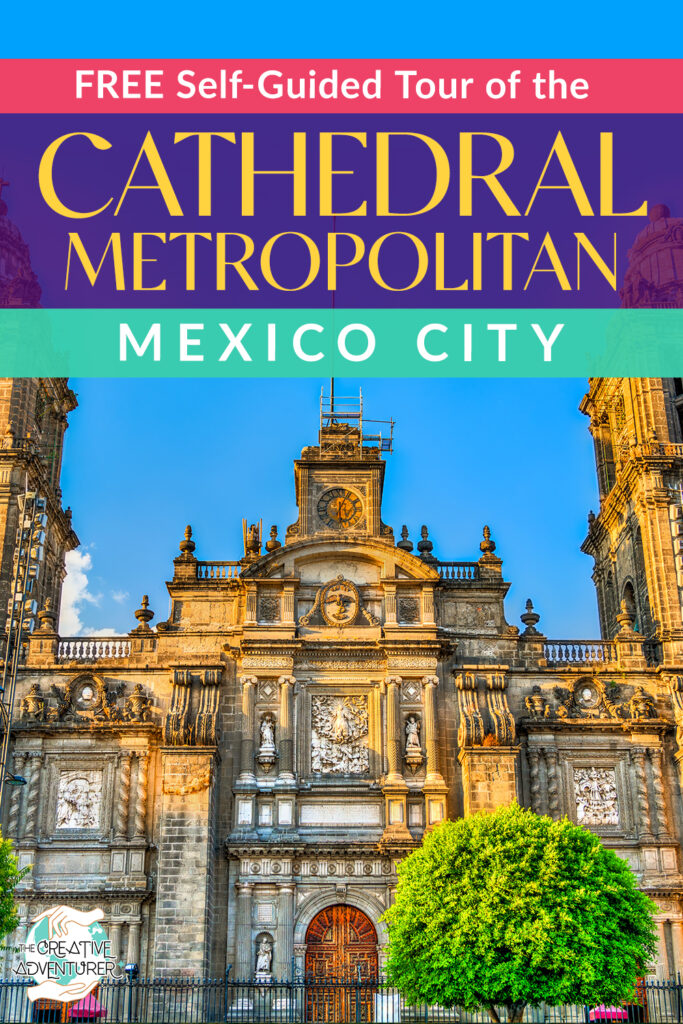
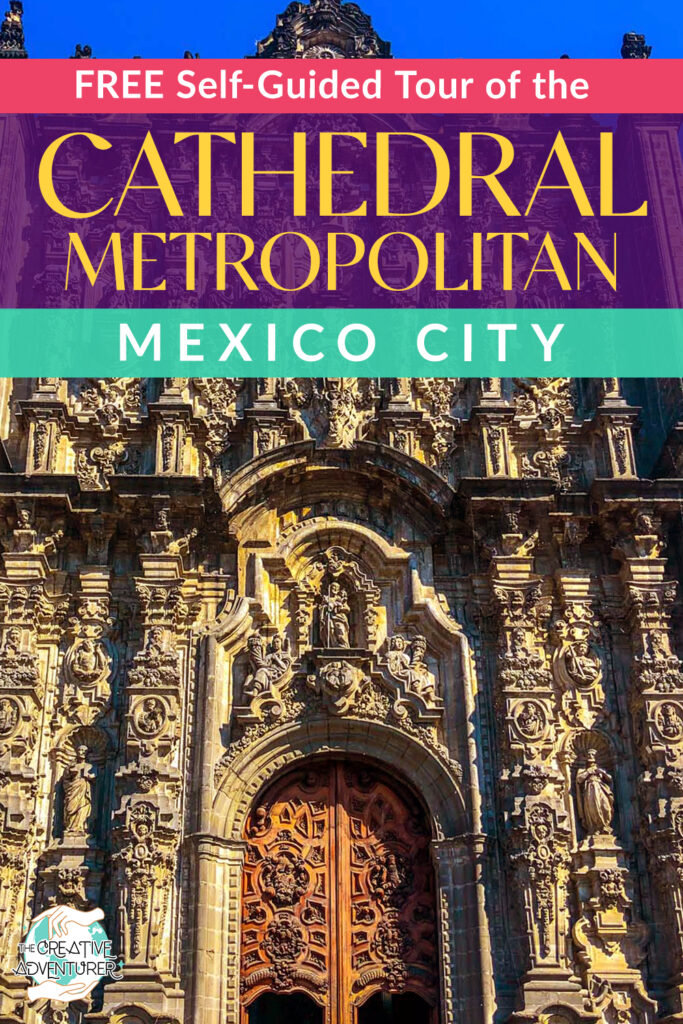
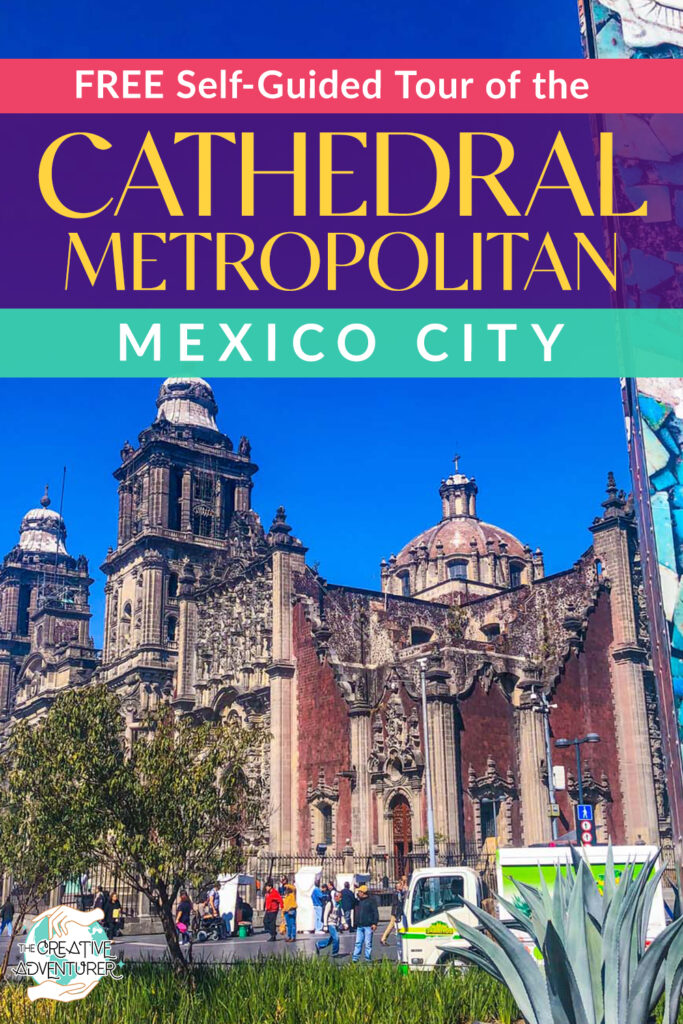
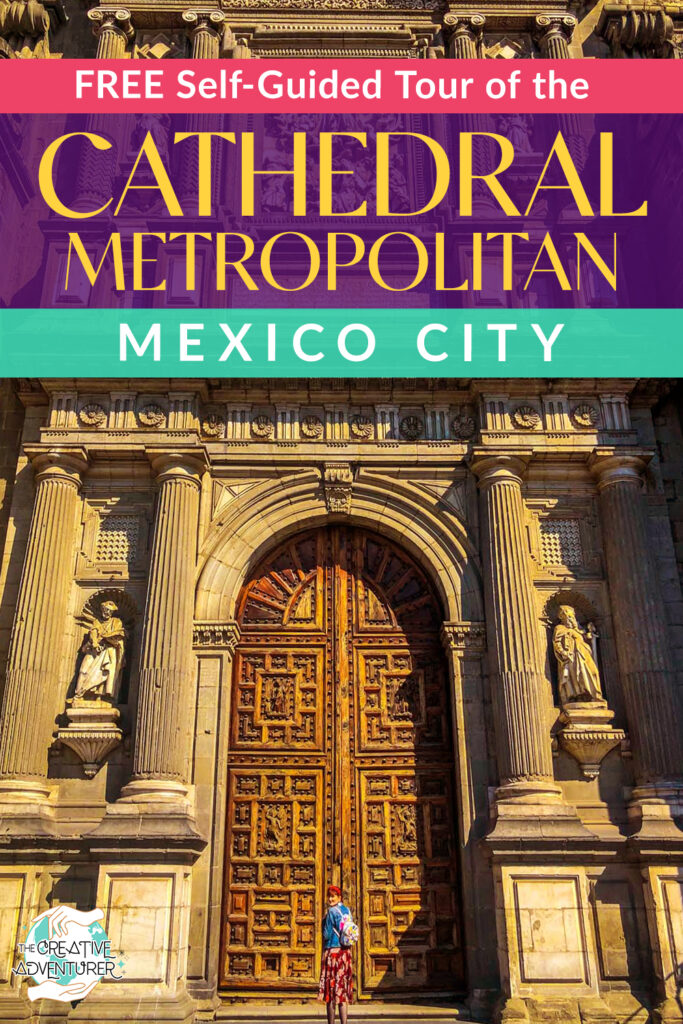

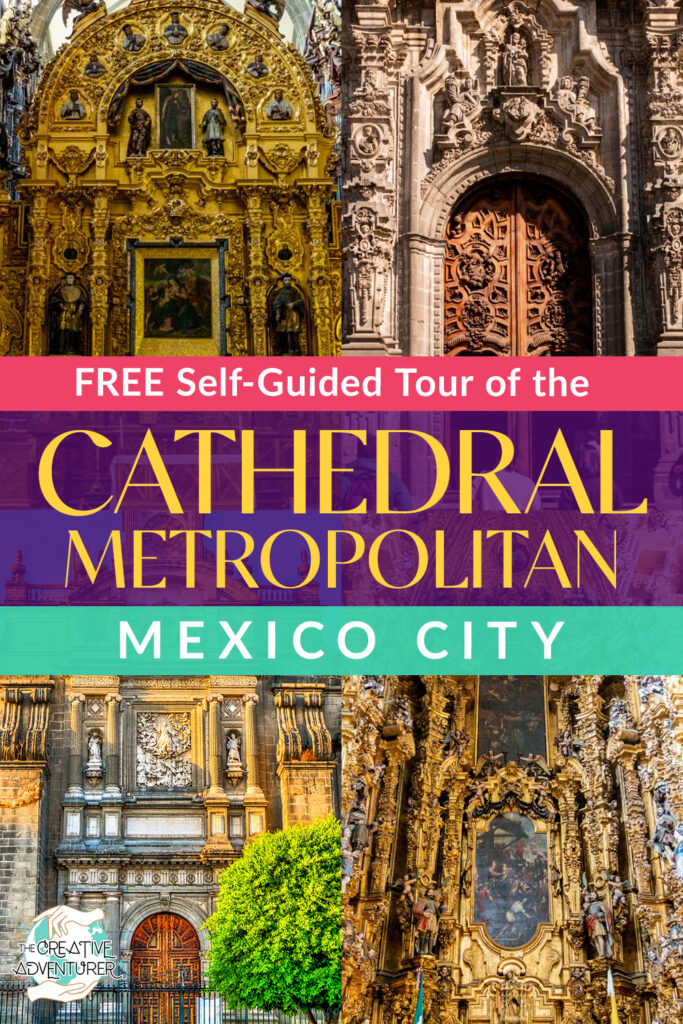


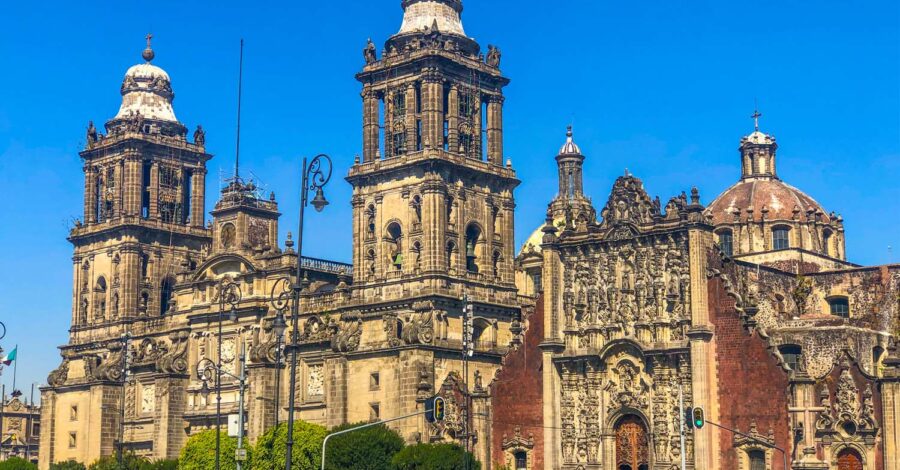
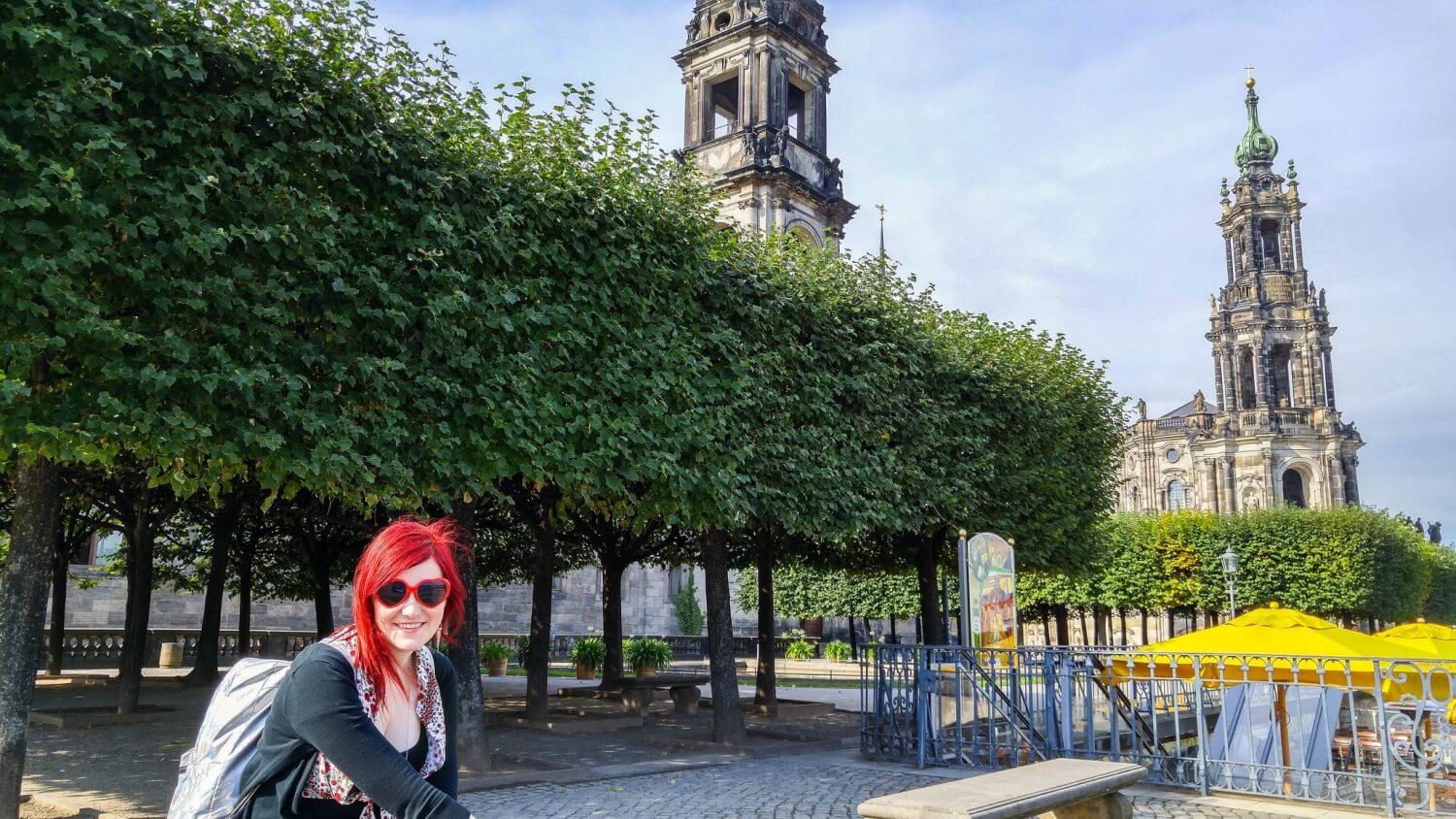
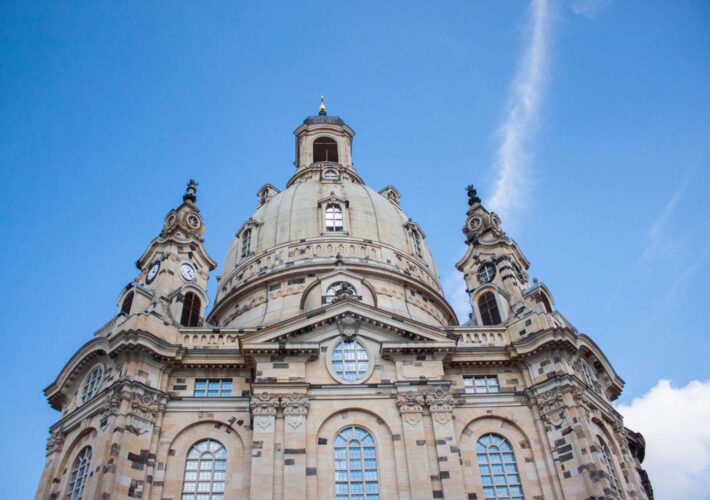
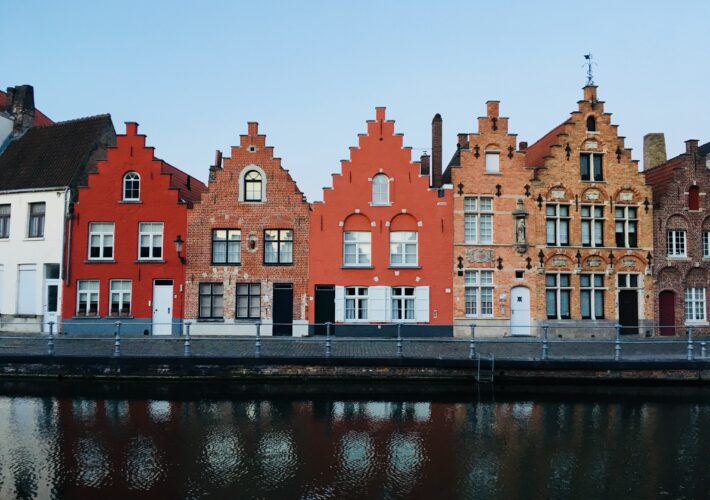
2 COMMENTS
Lidija
8 months agoWow! This is the best and most insightful and well-categorized guide on the Cathedral I’ve seen so far, and I was looking for more details in English everywhere. Thanks a lot for such an effort, it helped a lot!
The Creative Adventurer
8 months ago AUTHORThanks so much Lidija! That’s why I wrote it, because I had the same problems when I visited and it’s such an amazing place I wanted to make sure everyone could understand all the details about this place 🙂